14_JUC
前言
本次内容全部来自
环境准备
1、打开IDEA,新建一个maven项目
2、查看
什么是JUC
java.util.concurrent简称JUC,也就是下面的三个包

为什么要学习JUC
-
JUC面试高频问,所以一定要掌握
-
之前使用
Thread,非常普通的线程类Runnable,没有返回类型,效率相比于Callable相对较低 -
之前也学过Lock锁,但是没有深入的系统地学习JUC
面试的时候:单例模式,排序算法,生产者和消费者,死锁
线程和进程
一句话说明线程和进程?
1个进程至少包含1个线程
JAVA默认有几个线程?
2个:Main+GC垃圾回收
JAVA真的可以开启线程吗?
JAVA不可以开启线程,如果我们调用底层,我们会发现:
public synchronized void start() {
if (threadStatus != 0) throw new IllegalThreadStateException();
group.add(this);
boolean started = false;
try {
start0();
started = true;
} finally {
try {
if (!started) {
group.threadStartFailed(this);
}
} catch (Throwable ignore) {
/* do nothing. If start0 threw a Throwable then
it will be passed up the call stack */
}
}
}
这个start最后调用了一个很诡异的方法
start0(),这个其实是调用的本地方法,所以JAVA是没有资格直接操作硬件的
并发和并行
- 并发:多个线程操作一个资源
- CPU一核,但是要模拟出来多线程的操作,只能通过快速的交替来模拟这样的效果
- 一种假象
- 并行:多个人一起行走
- 多核CPU下面,多个线程可以同时执行
并发编程的本质:充分利用CPU的资源
public class JUC {
public static void main(String[] args) {
//获取cpu的核数
System.out.println(Runtime.getRuntime().availableProcessors());
}
}
获得CPU的核数
线程有几个状态?
public enum State {
NEW, //新生
RUNNABLE, //运行
BLOCKED, //阻塞
WAITING, //等待,永远等待
TIMED_WAITING,//超时等待,过时不候
TERMINATED; //终止
}
6个
wait和sleep的区别?
- 来自不同的类
wait来自Objectsleep来自Thread
- 锁的释放
wait会释放锁sleep不会释放锁
- 使用范围
wait:必须要在同步代码块中sleep:可以在任何地方使用
- 是否需要捕获异常
- wait和sleep都要捕获中断异常:InterruptedException
Lock锁
我们先聊传统:
synchronized
public class SaleTicketDemo {
public static void main(String[] args) {
new Thread(new MyThread()).start();
}
}
class MyThread implements Runnable{
@Override
public void run() {}
}
以前我们就是这么用的,但是今天开始要推翻
真正的多线程开发中
线程就是一个单独的资源类,没有任何附属的操作
public class SaleTicketDemo {
public static void main(String[] args) {
//多线程
//并发:多个线程操作同一个资源类
Ticket ticket = new Ticket();
new Thread(()->{
for (int i = 0; i < 40; i++) {
ticket.sale();
}
},"A").start();
new Thread(()->{
for (int i = 0; i < 40; i++) {
ticket.sale();
}
},"B").start();
new Thread(()->{
for (int i = 0; i < 40; i++) {
ticket.sale();
}
},"C").start();
}
}
//这就是资源类,对这个类进行操作叫做真正的OOP编程
//假如在这里实现一个Runnable,这就不叫面向对象了,就变成了一个线程类了,而且耦合性高
class Ticket{
//属性和方法
//属性
private int number = 50;
//方法,使用同步方法:synchronized
public synchronized void sale(){
if (number>0){
System.out.println(Thread.currentThread().getName() + "-->" + (number--) + ",剩余" + number);
}
}
}
上面是传统方式简单回顾
下面要用JUC
java.util.concurrent.locks
我们看到有三个接口,其中有一个Lock接口
Interface Lock,三个实现类ReentrantLock:可重用锁(常用)ReadLock:读锁WriteLock:写锁
我们查看ReentrantLock,我们发现这样一段源码
public ReentrantLock() {
sync = new NonfairSync(); //new一个新的非公平锁
}
public ReentrantLock(boolean fair) { //ReentrantLock的构造参数
sync = fair ? new FairSync() : new NonfairSync();
}
//假如为真,则为公平锁,否则为非公平锁
公平锁和非公平锁
- 公平锁:十分公平,必须先来后到
- 非公平锁:十分不公平,可以插队(默认)
默认为非公平锁,这是因为:
假如有两个线程,A执行3秒,B执行3小时,B先来的
假如为公平锁,那么A就要等3个小时
我们使用一下Lock锁,来举一个例子:
import java.util.concurrent.locks.Lock;
import java.util.concurrent.locks.ReentrantLock;
public class SaleTicketDemo2 {
public static void main(String[] args) {
Ticket ticket = new Ticket();
new Thread(()->{ for (int i = 0; i < 40; i++) ticket.sale(); },"A").start();
new Thread(()->{ for (int i = 0; i < 40; i++) ticket.sale(); },"B").start();
new Thread(()->{ for (int i = 0; i < 40; i++) ticket.sale(); },"C").start();
}
}
//Lock
class Ticket2{
private int number = 50;
Lock lock = new ReentrantLock();
public void sale(){
lock.lock();
try {
if (number>0){
System.out.println(Thread.currentThread().getName() + "-->" + (number--) + ",剩余" + number);
}
} finally {
lock.unlock();//在finally里面解锁
}
}
}
Lock和Synchronized的区别
1、Synchronized是内置的Java关键字,而Lock是一个Java类
2、Synchronized可重入锁,不可以中断的,非公平锁。Lock,可重入锁,可以判断锁是否中断,可以自己设置为公平锁或者非公平锁
3、Synchronized线程1(获得锁),线程2(死死地等待)。Lock就不一定会等待下去:lock.tryLock()尝试获取锁,获取不到就算了
4、Synchronized无法判断获取锁的状态,Lock可以判断是否获取到了锁
5、Synchronized会自动释放锁,而Lock必须手动释放。不释放可能会导致死锁
6、Synchronized适合锁少量的代码同步问题,Lock适合大量的同步代码
可重入锁的意思是,现在有两把锁,一外一里,拿到外面的锁就拿到了里面的锁,这也叫做递归锁
生产者和消费者问题
这是个大有门道的问题
老版方式
线程同步
老版方式:Synchronized
//等待,业务,通知:判断是否要进行等待,如果不等待就干活,干完活就通知另一方
class Data{//数字,资源类
private int number = 0;
//+1,对应生产者
public synchronized void increment() throws InterruptedException {
if (number!=0){
//等待
this.wait();
}
number++;
System.out.println(Thread.currentThread().getName() + "=>" + number);
//通知其他线程
this.notifyAll();
}
//-1,对应消费者
public synchronized void decrement() throws InterruptedException {
if (number==0){
//等待
this.wait();
}
number--;
System.out.println(Thread.currentThread().getName() + "=>" + number);
//通知其他线程
this.notifyAll();
}
}
/*
线程之间的通信问题:生产者和消费者问题
线程交替执行,A和B操作同一个变量,num
A num+1
B num-1
*/
public class A {
public static void main(String[] args) {
Data data = new Data();
new Thread(()->{
for (int i = 0; i < 10; i++) {
try {
data.increment();
} catch (InterruptedException e) {
e.printStackTrace();
}
}
},"A").start();
new Thread(()->{
for (int i = 0; i < 10; i++) {
try {
data.decrement();
} catch (InterruptedException e) {
e.printStackTrace();
}
}
},"B").start();
/*
A=>1 B=>0 A=>1 B=>0 A=>1 B=>0
A=>1 B=>0 A=>1 B=>0 A=>1 B=>0
A=>1 B=>0 A=>1 B=>0 A=>1 B=>0
A=>1 B=>0
*/
}
}
虚假唤醒
问题来了:现在只有两个线程,但是我们加到了四个线程,甚至八个线程,结果呢?
我们让A和C加,B和D减
public class A {
public static void main(String[] args) {
Data data = new Data();
new Thread(()->{
for (int i = 0; i < 5; i++) {
try {
data.increment();
} catch (InterruptedException e) {
e.printStackTrace();
}
}
},"A").start();
new Thread(()->{
for (int i = 0; i < 5; i++) {
try {
data.decrement();
} catch (InterruptedException e) {
e.printStackTrace();
}
}
},"B").start();
new Thread(()->{
for (int i = 0; i < 5; i++) {
try {
data.increment();
} catch (InterruptedException e) {
e.printStackTrace();
}
}
},"C").start();
new Thread(()->{
for (int i = 0; i < 5; i++) {
try {
data.decrement();
} catch (InterruptedException e) {
e.printStackTrace();
}
}
},"D").start();
/*
A=>1 B=>0 C=>1 A=>2 C=>3
B=>2 B=>1 B=>0 C=>1 A=>2
C=>3 B=>2 C=>3 A=>4 D=>3
D=>2 D=>1 D=>0 A=>1 D=>0
*/
}
}
//等待,业务,通知:判断是否要进行等待,如果不等待就干活,干完活就通知另一方
class Data{//数字,资源类
private int number = 0;
//+1,对应生产者
public synchronized void increment() throws InterruptedException {
if (number!=0){
//等待
this.wait();
}
number++;
System.out.println(Thread.currentThread().getName() + "=>" + number);
//通知其他线程
this.notifyAll();
}
//-1,对应消费者
public synchronized void decrement() throws InterruptedException {
if (number==0){
//等待
this.wait();
}
number--;
System.out.println(Thread.currentThread().getName() + "=>" + number);
//通知其他线程
this.notifyAll();
}
}
结果来了,同步凉了
那么为什么会出现这种问题呢?因为用了if判断,有的时候就会出现这种问题,这种问题叫做虚假唤醒
查看jdk文档:java.lang-->Object-->wait/notify

注意点,这里要防止虚假唤醒
虚假唤醒就是当一个条件满足时,很多线程都被唤醒了,但是只有部分是有用的唤醒,其余的都是无用功
解决方案:条件判断的时候,把if改为while
public class A {
public static void main(String[] args) {
Data data = new Data();
new Thread(()->{
for (int i = 0; i < 5; i++) {
try {
data.increment();
} catch (InterruptedException e) {
e.printStackTrace();
}
}
},"A").start();
new Thread(()->{
for (int i = 0; i < 5; i++) {
try {
data.decrement();
} catch (InterruptedException e) {
e.printStackTrace();
}
}
},"B").start();
new Thread(()->{
for (int i = 0; i < 5; i++) {
try {
data.increment();
} catch (InterruptedException e) {
e.printStackTrace();
}
}
},"C").start();
new Thread(()->{
for (int i = 0; i < 5; i++) {
try {
data.decrement();
} catch (InterruptedException e) {
e.printStackTrace();
}
}
},"D").start();
}
}
class Data{
private int number = 0;
public synchronized void increment() throws InterruptedException {
while (number!=0){ //这里为了防止虚假唤醒,改为使用while
this.wait();
}
number++;
System.out.println(Thread.currentThread().getName() + "=>" + number);
this.notifyAll();
}
public synchronized void decrement() throws InterruptedException {
while (number==0){ //这里为了防止虚假唤醒,改为使用while
this.wait();
}
number--;
System.out.println(Thread.currentThread().getName() + "=>" + number);
this.notifyAll();
}
}
JUC方式
新老三剑客对应
传统三剑客:Synchronized,wait,notify
其中synchronized被Lock替换了,那么根据逻辑来讲,其余两个也是有替换的
java.util.concurrent.locks
- Condition
- Lock
- ReadWriteLock
那么Condition就是配套的三剑客之一,对应老版的wait和notify

从官方文档我们可以看出来,Condition替代了对象的监视器的方法,原来我们使用wait和notify,现在就要使用Condition
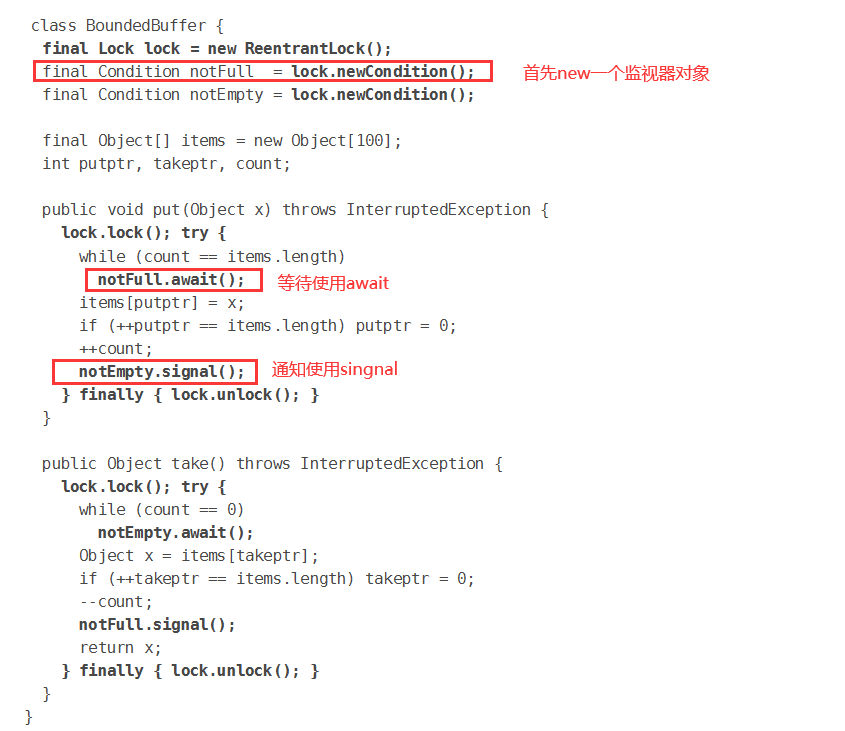
那么对应关系来了:

代码实现一下:
public class B {
public static void main(String[] args) {
Data2 data = new Data2();
new Thread(()->{
for (int i = 0; i < 5; i++) {
try {
data.increment();
} catch (InterruptedException e) {
e.printStackTrace();
}
}
},"A").start();
new Thread(()->{
for (int i = 0; i < 5; i++) {
try {
data.decrement();
} catch (InterruptedException e) {
e.printStackTrace();
}
}
},"B").start();
new Thread(()->{
for (int i = 0; i < 5; i++) {
try {
data.increment();
} catch (InterruptedException e) {
e.printStackTrace();
}
}
},"C").start();
new Thread(()->{
for (int i = 0; i < 5; i++) {
try {
data.decrement();
} catch (InterruptedException e) {
e.printStackTrace();
}
}
},"D").start();
}
}
class Data2{
private int number = 0;
Lock lock = new ReentrantLock();
Condition condition = lock.newCondition();//取代了wait和notify
public void increment() throws InterruptedException {
lock.lock();
try {
while (number!=0){
//等待
condition.await();
}
number++;
System.out.println(Thread.currentThread().getName() + "=>" + number);
//通知
condition.signalAll();
} finally {
lock.unlock();
}
}
public void decrement() throws InterruptedException {
lock.lock();
try {
while (number==0){
//等待
condition.await();
}
number--;
System.out.println(Thread.currentThread().getName() + "=>" + number);
//通知
condition.signalAll();
} finally {
lock.unlock();
}
}
}
上面这个可以了,但是好像没有什么区别
那么这个好像和原来的技术没什么区别,那么我为什么要用新技术?
精准通知,有序执行
Condition 新技术可以让线程有序的执行,精准的通知和唤醒线程
//资源类使用Lock锁,要求A执行完调用B,B执行完调用C,C执行完调用A
class Data3{
private Lock lock = new ReentrantLock();
//因为一个同步监视器只能监视一个线程,所以我们使用三个监视器,然后通过监视器来判断我们来唤醒什么
private Condition condition1 = lock.newCondition();
private Condition condition2 = lock.newCondition();
private Condition condition3 = lock.newCondition();
//我们让number为1的时候执行A,number为2执行B,number为3执行C
private int number = 1;
public void printA(){
lock.lock();
try {
//判断是否等待
while (number!=1){
//等待
condition1.await();
}
//执行
System.out.println(Thread.currentThread().getName()+"=>A");
//通知,唤醒B
number=2;
condition2.signal();
} catch (InterruptedException e) {
e.printStackTrace();
} finally {
lock.unlock();
}
}
public void printB(){
lock.lock();
try {
//判断是否等待
while (number!=2){
//等待
condition2.await();
}
//执行
System.out.println(Thread.currentThread().getName()+"=>B");
//通知,唤醒B
number=3;
condition3.signal();
} catch (InterruptedException e) {
e.printStackTrace();
} finally {
lock.unlock();
}
}
public void printC(){
lock.lock();
try {
//判断是否等待
while (number!=3){
//等待
condition3.await();
}
//执行
System.out.println(Thread.currentThread().getName()+"=>C");
//通知,唤醒B
number=1;
condition1.signal();
} catch (InterruptedException e) {
e.printStackTrace();
} finally {
lock.unlock();
}
}
}
import java.util.concurrent.locks.Condition;
import java.util.concurrent.locks.Lock;
import java.util.concurrent.locks.ReentrantLock;
public class C {
public static void main(String[] args) {
Data3 data = new Data3();
new Thread(()->{ for (int i = 0; i < 3; i++) data.printA(); },"A").start();
new Thread(()->{for (int i = 0; i < 3; i++) data.printB();},"B").start();
new Thread(()->{for (int i = 0; i < 3; i++) data.printC();},"C").start();
/*
A=>A B=>B C=>C
A=>A B=>B C=>C
A=>A B=>B C=>C
*/
}
}
八锁现象彻底理解锁
如何判断锁的谁 ?,什么是锁?
锁只会锁两个东西:对象,Class模板
先发短信还是先打电话?
八锁其实是八个问题,我们以先发短信还是先打电话作为这个问题,在不同的情况下分析八次
- 标准情况下,两个线程先打印发短信还是先打印打电话
class Phone{
public synchronized void sendMessage(){
System.out.println("发短信");
}
public synchronized void call(){
System.out.println("打电话");
}
}
import java.util.concurrent.TimeUnit;
public class Lock1 {
public static void main(String[] args) {
Phone phone = new Phone();
new Thread(()->{
phone.sendMessage();
},"A").start();
try {
//公司中使用这个工具类来实现休眠,这里休眠一秒
TimeUnit.SECONDS.sleep(1);
} catch (InterruptedException e) {
e.printStackTrace();
}
new Thread(()->{
phone.call();
},"B").start();
}
}
这里应该是和先发短信,然后再打电话
原因不是在于谁先调用的,而是在于谁先获得的锁
这里的锁是锁住的对象,而两者都是同一个对象的方法
所以为了同步,谁先获得锁,谁就先执行
中间加了那一秒的延迟其实是个陷阱
- 发短信延迟4秒,谁先执行?
class Phone2{
public synchronized void sendMessage(){
try {
TimeUnit.SECONDS.sleep(4);
} catch (InterruptedException e) {
e.printStackTrace();
}
System.out.println("发短信");
}
public synchronized void call(){
System.out.println("打电话");
}
}
import java.util.concurrent.TimeUnit;
public class Lock2 {
public static void main(String[] args) {
Phone2 phone = new Phone2();
new Thread(()->{
phone.sendMessage();
},"A").start();
new Thread(()->{
phone.call();
},"B").start();
}
}
还是先发短信,然后再打电话
这个问题和第一个问题没有本质区别,都是考验锁的问题
锁是锁的对象,所以两者的锁都是同一把
谁先获得锁,谁就先执行
中间停顿的4秒是陷阱
- 改变一个为普通方法之后,谁先执行?
class Phone3{
public synchronized void sendMessage(){
try {
TimeUnit.SECONDS.sleep(4);
} catch (InterruptedException e) {
e.printStackTrace();
}
System.out.println("发短信");
}
public void call(){
System.out.println("打电话");
}
}
import java.util.concurrent.TimeUnit;
public class Lock3 {
public static void main(String[] args) {
Phone3 phone = new Phone3();
new Thread(()->{
phone.sendMessage();
},"A").start();
new Thread(()->{
phone.call();
},"B").start();
}
}
这个答案是先打电话
因为打电话不是一个同步方法,所以不用获取锁
这次的延迟不是一个陷阱
- 两个对象,两个方法,谁先执行
class Phone4{
public synchronized void sendMessage(){
try {
TimeUnit.SECONDS.sleep(4);
} catch (InterruptedException e) {
e.printStackTrace();
}
System.out.println("发短信");
}
public synchronized void call(){
System.out.println("打电话");
}
}
public class Lock4 {
public static void main(String[] args) {
Phone4 phone1 = new Phone4();
Phone4 phone2 = new Phone4();
new Thread(()->{
phone1.sendMessage();
},"A").start();
new Thread(()->{
phone2.call();
},"B").start();
}
}
这里应该是先打电话
本质上的问题还是锁
这个锁是锁的对象,所以两个对象的锁并不是同一把
但是因为发短信延迟了四秒钟,所以先打电话
- 一个对象,两个静态同步方法,谁先执行?
class Phone5{
public static synchronized void sendMessage(){
try {
TimeUnit.SECONDS.sleep(4);
} catch (InterruptedException e) {
e.printStackTrace();
}
System.out.println("发短信");
}
public static synchronized void call(){
System.out.println("打电话");
}
}
import java.util.concurrent.TimeUnit;
public class Lock5 {
public static void main(String[] args) {
Phone5 phone = new Phone5();
new Thread(()->{
phone.sendMessage();
},"A").start();
new Thread(()->{
phone.call();
},"B").start();
}
}
这个题的答案应该是先执行发短信
但是如果是按照之前根据同一把锁,锁的对象来回答的话,那么答案不正确
因为加入了
static关键字,表明了这是一个静态加载,说明了类一加载就有了所以这个锁的是Class模板,就是
Phone5.class,而不是锁的对象打电话和发短信虽然争抢的是同一把锁,但是他们争抢的是Class的锁而不是对象的锁
- 两个对象,两个静态同步方法,谁先执行?
class Phone6{
public static synchronized void sendMessage(){
try {
TimeUnit.SECONDS.sleep(4);
} catch (InterruptedException e) {
e.printStackTrace();
}
System.out.println("发短信");
}
public static synchronized void call(){
System.out.println("打电话");
}
}
import java.util.concurrent.TimeUnit;
public class Lock6 {
public static void main(String[] args) {
Phone6 phone1 = new Phone6();
Phone6 phone2 = new Phone6();
new Thread(()->{
phone1.sendMessage();
},"A").start();
new Thread(()->{
phone2.call();
},"B").start();
}
}
还是先发短信再打电话
因为他们两个争抢的是Class模板的锁,而不是对象的锁
所以有几个对象都无所谓
谁先抢到Class的锁,谁就先执行
- 一个静态同步方法,一个普通同步方法是,一个对象,谁先执行?
class Phone7{
public static synchronized void sendMessage(){
try {
TimeUnit.SECONDS.sleep(4);
} catch (InterruptedException e) {
e.printStackTrace();
}
System.out.println("发短信");
}
public synchronized void call(){
System.out.println("打电话");
}
}
import java.util.concurrent.TimeUnit;
public class Lock8 {
public static void main(String[] args) {
Phone7 phone = new Phone7();
new Thread(()->{
phone.sendMessage();
},"A").start();
new Thread(()->{
phone.call();
},"B").start();
}
}
应当是先打电话,在发短信
因为这个问题他们争抢的不是一把锁
发短信抢的是Class模板锁,打电话争抢的是对象锁
又因为发短信延迟4秒执行
所以先执行打电话
- 两个对象,一个静态同步,一个普通同步,谁先执行?
class Phone8{
public static synchronized void sendMessage(){
try {
TimeUnit.SECONDS.sleep(4);
} catch (InterruptedException e) {
e.printStackTrace();
}
System.out.println("发短信");
}
public synchronized void call(){
System.out.println("打电话");
}
}
import java.util.concurrent.TimeUnit;
public class Lock8 {
public static void main(String[] args) {
Phone7 phone1 = new Phone7();
Phone7 phone2 = new Phone7();
new Thread(()->{
phone1.sendMessage();
},"A").start();
new Thread(()->{
phone2.call();
},"B").start();
}
}
先打电话,然后发短信
因为两个争抢的不是一把锁
又因为发短信慢四秒
所以先打电话
集合类不安全
List不安全的解决
一个普通的List集合
public class ListTest {
public static void main(String[] args) {
List<String> list = new ArrayList<>();
//报错了:java.util.ConcurrentModificationException
for (int i = 1; i <= 10; i++) {
new Thread(()->{
list.add(UUID.randomUUID().toString().substring(0,5));
System.out.println(list);
},String.valueOf(i)).start();
}
}
}
这个是不安全的,结果就是报错了,报错:
java.util.ConcurrentModificationException并发修改异常
并发下ArrayList是不安全的
解决方案(普通层面)
-
使用
Vector:List<String> list = new Vector<>();但是
Vector虽然可行,但是面试不会给高分的,因为Vector比ArrayList出现的时间早那么为什么JDK要出现一个线程不安全的
ArrayList来替代Vector呢?肯定是比Vector更加高效,那么现在我回退了版本使用旧技术,简直是自寻死路
-
通过工具类转换:
Collectionspublic class ListTest { public static void main(String[] args) { List<String> list = Collections.synchronizedList(new ArrayList<>()); //报错了:java.util.ConcurrentModificationException for (int i = 1; i <= 10; i++) { new Thread(()->{ list.add(UUID.randomUUID().toString().substring(0,5)); System.out.println(list); },String.valueOf(i)).start(); } } }既然
ArrayList不安全,那么我们让它变得安全不就行了么?集合的老大Collections,可以帮助我们解决这个问题,进行同步
转变为
Synchronized但是其实这个答案和Vector并没有区别,因为Vector也是使用了
Synchronized
解决方案(JUC)
打开jdk文档,翻到java.util.concurrent包下,找到对应的class:CopyOnWriteArrayList
这个就是JUC下面的解决方案
import java.util.concurrent.CopyOnWriteArrayList;
public class ListTest {
public static void main(String[] args) {
List<String> list = new CopyOnWriteArrayList<>();
//报错了:java.util.ConcurrentModificationException
for (int i = 1; i <= 10; i++) {
new Thread(()->{
list.add(UUID.randomUUID().toString().substring(0,5));
System.out.println(list);
},String.valueOf(i)).start();
}
}
}
CopyOnWrite:写入时复制,简称COW,是计算机程序设计领域的一种优化策略
有多个线程调用的时候,比如调用list,list是唯一的,在读取的时候是固定的,但是写入的时候不能让他们同时写,因为A写完之后可能B就把A给覆盖了,那么现在就有:在写入的时候复制一份,写完之后交给调用者,这样就在写入的时候避免覆盖,造成数据问题
这里涉及到一个读写分离的思想
走底层,发现
private transient volatile Object[] array;
这里又看不懂了,但是下面会讲
那么CopyOnWriteArrayList比Vector牛逼在哪里
我们找一下Vector的源码
public synchronized boolean add(E e) {
modCount++;
ensureCapacityHelper(elementCount + 1);
elementData[elementCount++] = e;
return true;
}
我们不可避免的发现了Vector使用了
synchronized这在意料之中
我们再查看CopyOnWriteArrayList
public boolean add(E e) {
final ReentrantLock lock = this.lock;
lock.lock();
try {
Object[] elements = getArray();
int len = elements.length;
Object[] newElements = Arrays.copyOf(elements, len + 1); //拿过来的时候复制一份
newElements[len] = e;
setArray(newElements); //还回去
return true;
} finally {
lock.unlock();
}
}
我们看到它使用了Lock锁
其中在拿过来的时候去复制一份
还回去的时候交给他
Set不安全的解决

首先做一个铺垫:List,Set,BlockingQueue
我们知道有List,Set,但是
BlockingQueue(阻塞队列)是第一次听,和List,Set同级先知道有这个东西就好了
Set其实和List没有区别
public class SetTest {
public static void main(String[] args) {
Set<String> set = new HashSet<>();
for (int i = 1; i <= 10; i++) {
new Thread(()->{
set.add(UUID.randomUUID().toString().substring(0,5));
set.forEach(System.out::println);
}).start();
}
}
}
Exception in thread "Thread-3" java.util.ConcurrentModificationException并发修改异常
解决方案(类似List)
-
Set没有类似于Vector这样顶替的方式,所以直接上工具类
public class SetTest { public static void main(String[] args) { // Set<String> set = new HashSet<>(); Set<String> set = Collections.synchronizedSet(new HashSet<>()); for (int i = 1; i <= 10; i++) { new Thread(()->{ set.add(UUID.randomUUID().toString().substring(0,5)); set.forEach(System.out::println); }).start(); } } }通过工具类转为
Synchronized -
JUC的解决方法
public class SetTest { public static void main(String[] args) { // Set<String> set = new HashSet<>(); // Set<String> set = Collections.synchronizedSet(new HashSet<>()); Set<String> set = new CopyOnWriteArraySet(); for (int i = 1; i <= 10; i++) { new Thread(()->{ set.add(UUID.randomUUID().toString().substring(0,5)); set.forEach(System.out::println); }).start(); } } }
Set的底层是什么
查看HashSet的第层:
public HashSet() {
map = new HashMap<>();
}
清楚了吧,HashSet的第层其实是new了一个HashMap
但是还没完
public boolean add(E e) {
return map.put(e, PRESENT)==null;
}
这次看清楚了吧,HashSet的add方法其实就是
hashmap的put进去的值的key,也就是键而这个
PRESENTprivate static final Object PRESENT = new Object();随便来了一个Object
所以HashSet的本质就是HashMap的key,因为key是无法重复的
所以JDK官方也是够坑爹的
HashMap不安全的解决
首先有两个问题:
//map是这样用的吗?默认等价于什么?
Map<String, String> map = new HashMap<>();
1、工作中不用HashMap
2、默认等价于new HashMap(16,0.75);
看到这里我们需要先看一看源码
public HashMap(int initialCapacity, float loadFactor) { if (initialCapacity < 0) throw new IllegalArgumentException("Illegal initial capacity: " + initialCapacity); if (initialCapacity > MAXIMUM_CAPACITY) initialCapacity = MAXIMUM_CAPACITY; if (loadFactor <= 0 || Float.isNaN(loadFactor)) throw new IllegalArgumentException("Illegal load factor: " + loadFactor); this.loadFactor = loadFactor; this.threshold = tableSizeFor(initialCapacity); }public HashMap(int initialCapacity) { this(initialCapacity, DEFAULT_LOAD_FACTOR); }public HashMap() { this.loadFactor = DEFAULT_LOAD_FACTOR; // all other fields defaulted }
这三个重载其中有两个重载的变量需要重视:
loadFactor:加载因子,默认加载因子0.75
initialCapacity:初始容量,默认16,这个16是位运算的16static final int DEFAULT_INITIAL_CAPACITY = 1 << 4; // aka 16
重点是这个不安全
public class MapTest {
public static void main(String[] args) {
//map是这样用的吗?默认等价于什么?
Map<String, String> map = new HashMap<>();
for (int i = 0; i < 10; i++) {
new Thread(()->{
map.put(Thread.currentThread().getName(), UUID.randomUUID().toString().substring(0,5));
System.out.println(map);
},String.valueOf(i)).start();
}
}
}
java.util.ConcurrentModificationException并发修改异常
解决方案
-
Collectionspublic class MapTest { public static void main(String[] args) { //map是这样用的吗?默认等价于什么? Map<String, String> map = Collections.synchronizedMap(new HashMap<>()); for (int i = 0; i < 10; i++) { new Thread(()->{ map.put(Thread.currentThread().getName(), UUID.randomUUID().toString().substring(0,5)); System.out.println(map); },String.valueOf(i)).start(); } } } -
JUC中没有CopyOnWritexxx,注意,名字变了,叫做
ConcurrentHashMap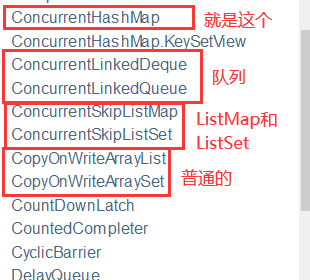
public class MapTest { public static void main(String[] args) { //map是这样用的吗?默认等价于什么? Map<String, String> map = new ConcurrentHashMap(); for (int i = 0; i < 10; i++) { new Thread(()->{ map.put(Thread.currentThread().getName(), UUID.randomUUID().toString().substring(0,5)); System.out.println(map); },String.valueOf(i)).start(); } } }
对于ConcurrentHashMap,看源码
public ConcurrentHashMap(int initialCapacity,float loadFactor, int concurrencyLevel) {
if (!(loadFactor > 0.0f) || initialCapacity < 0 || concurrencyLevel <= 0)
//假如负载因子>0或者初始化的长度<0或者并发级别<=0,那么就抛出非法异常
throw new IllegalArgumentException();
if (initialCapacity < concurrencyLevel) //假如初始化长度<并发级别
initialCapacity = concurrencyLevel; // 令初始化长度=并发级别
long size = (long)(1.0 + (long)initialCapacity / loadFactor);
int cap = (size >= (long)MAXIMUM_CAPACITY) ?
MAXIMUM_CAPACITY : tableSizeFor((int)size);
this.sizeCtl = cap;
}
Callable
什么是Callable
java.util.concurrent .Interface Callable<V>
-
Callable接口类似于Runnable然而,
Runnable不返回结果,也不能抛出被检查的异常
-
Callable可以有返回值 -
Callable可以抛出异常 -
Callable方法不同,Thread中继承的叫做run(),Callable中继承的叫做call()@FunctionalInterface public interface Callable<V> { V call() throws Exception; }泛型就是返回值
现在有一个问题:
Thread没法直接启动Callable
因为Thread只能直接和Runnable挂上钩,但是没法和Callable挂上钩,从源码中可以看出
public Thread(Runnable target) {
init(null, target, "Thread-" + nextThreadNum(), 0);
}
那么我们知道了,因为Callable没法直接和Thread挂上钩,但是如果我们想办法,把Callable和Runnable挂上钩,那么不就间接的实现目的了么?
java也是这么想的
java.lang.Runnable中有

我们查看FutureTask这个Runnable的实现类

我们看到了,构造方法可以和Runnable挂上关系,也可以和Callable挂上关系
所以结果清晰明了:
Callable勾搭上了FutureTask,而FutureTask是Runnable的实现类,而Runnable和Thread有关系
这就完美的实现了Callable<————>Thread
new Thread(()->{new FutureTask<V>(Callable)}).start()
所以Thread就可以启动Callable了
import java.util.concurrent.Callable;
import java.util.concurrent.ExecutionException;
import java.util.concurrent.FutureTask;
public class CallableTest {
public static void main(String[] args) throws ExecutionException, InterruptedException {
FutureTask futureTask = new FutureTask(new MyThread());
new Thread(futureTask,"A").start();
Integer i = (Integer)futureTask.get();
System.out.println(i);
}
}
class MyThread implements Callable<Integer> {
@Override
public Integer call() throws Exception {
System.out.println("call()");
return 123123;
}
}
注意点:
futureTask.get()这个方法可能会造成阻塞,结果可能会阻塞所以一般我们有两种解决方案:
- 放到最后一行
- 异步通信
注意点,假如我们启用两个线程:
public class CallableTest { public static void main(String[] args) throws ExecutionException, InterruptedException { FutureTask futureTask = new FutureTask(new MyThread()); new Thread(futureTask,"A").start(); new Thread(futureTask,"B").start(); Integer i = (Integer)futureTask.get(); System.out.println(i); } } class MyThread implements Callable<Integer> { @Override public Integer call() throws Exception { System.out.println("call()"); return 123123; } }结果却是:
call()
123123这个说明结果有缓存,这是一个小坑
常用的辅助类
java.util.concurrent
CountDownLatch
减法计数器,两个方法
countDownLatch.countDown():每当有一个线程执行一次,减法计数器减一(计数)countDownLatch.await():等待计数器归零,才能执行这行代码之后的代码(拦截器)
import java.util.concurrent.CountDownLatch;
public class CountDownLatchDemo {
public static void main(String[] args) {
//假设我们设置计数器为6
CountDownLatch countDownLatch = new CountDownLatch(6);
for (int i = 0; i < 6; i++) {
final int temp = i;
new Thread(()->{
System.out.println("这是第"+temp+"个"); //这里要注意了,因为lambda最终是new了一个接口,所以不能直接操作i
countDownLatch.countDown();//计数器减一
},String.valueOf(i)).start();
}
try {
countDownLatch.await(); //这里是等待计数器归零之后才可以执行后面的代码
} catch (InterruptedException e) {
e.printStackTrace();
}
System.out.println("计数器归零");
}
}
CyclicBarrier
加法计数器,两个方法
两个构造函数,其中一个构造函数的作用是指定好计数器的个数,并且指定在达到计数器的个数的时候执行的线程
cyclicBarrier.await():等待线程执行完毕之后执行后面的方法
import java.util.concurrent.BrokenBarrierException;
import java.util.concurrent.CyclicBarrier;
public class CyclicBarrierDemo {
public static void main(String[] args) {
CyclicBarrier cyclicBarrier = new CyclicBarrier(7,()->{
System.out.println("执行后来的线程");//当七个线程都执行的时候,那么就开始执行这个线程
});
for (int i = 0; i < 7; i++) {
int temp = i+1;
new Thread(()->{
System.out.println("这里是第"+temp+"个线程");
try {
cyclicBarrier.await();//等待7个线程
} catch (InterruptedException e) {
e.printStackTrace();
} catch (BrokenBarrierException e) {
e.printStackTrace();
}
}).start();
}
}
}
假如它要传递多余七个线程,但是其实达不到这个数量,那么程序就会卡在这里
Semaphore
信号量,让线程可以等待,让线程在有限的情况下有秩序的执行,限流可以使用
就像抢车位,假如有6辆车,三个车位,那就需要抢车位
acquire():得到,假设得不到那么等待信号量被释放位置release():释放当前的信号量,唤醒等待的线程
import java.util.concurrent.Semaphore;
import java.util.concurrent.TimeUnit;
public class SemaphoreDemo {
public static void main(String[] args) {
//信号量,这里可以理解为车位
Semaphore semaphore = new Semaphore(3);
//有6个线程需要争抢
for (int i = 1; i <= 6; i++) {
new Thread(()->{
try {
semaphore.acquire();//得到
System.out.println(Thread.currentThread().getName()+"得到");
TimeUnit.SECONDS.sleep(2);//模拟线程操作,休息两秒钟
} catch (InterruptedException e) {
e.printStackTrace();
}finally {
semaphore.release();//释放
}
},String.valueOf(i)).start();
}
}
}
ReadWriteLock
读写锁,
java.util.concurrent
为了提高工作的效率,读写锁规定:读取可以由多个线程读取,写则只能有一个线程去写
writeLock():写锁,也称独占锁lock()unlock()
readLock():读锁,也称共享锁lock()unlock()
这个意思是说:
读写锁中,要么进行读取,要么进行写入,不可以两个一起。
然而读锁是共享锁,所以可以使用多个线程一起读。
写锁是独占锁,只能有一个线程进行写入操作。
//自定义缓存
class MyCache{
private volatile Map<String,Object> map = new HashMap<>();
//这个是读写锁,可以实现更加细粒度的操作,就是读取可以多线程操作,写入只能一个线程
private ReadWriteLock readWriteLock = new ReentrantReadWriteLock();
//写
public void put(String key,Object value){
readWriteLock.writeLock().lock();//加了一把写锁,更加细粒度的划分了读锁和写锁
try {
System.out.println(Thread.currentThread().getName()+"写入"+key);
map.put(key,value);
System.out.println(Thread.currentThread().getName()+"写入ok");
} catch (Exception e) {
e.printStackTrace();
} finally {
readWriteLock.writeLock().unlock();//解锁
}
}
//读
public void get(String key){
readWriteLock.readLock().lock(); //读取锁
try {
System.out.println(Thread.currentThread().getName()+"读取"+key);
Object o = map.get(key);
System.out.println(Thread.currentThread().getName()+"读取ok");
} catch (Exception e) {
e.printStackTrace();
} finally {
readWriteLock.readLock().unlock();//解锁
}
}
}
import java.util.HashMap;
import java.util.Map;
import java.util.concurrent.locks.ReadWriteLock;
import java.util.concurrent.locks.ReentrantReadWriteLock;
public class ReadWriteLockDemo {
public static void main(String[] args) {
MyCache cache = new MyCache();
for (int i = 0; i < 5; i++) {
final int temp = i+1;
new Thread(()->{
cache.put(temp+"",temp+"");
},String.valueOf(temp)).start();
}
for (int i = 0; i < 5; i++) {
final int temp = i+1;
new Thread(()->{
cache.get(temp+"");
},String.valueOf(temp)).start();
}
}
}
阻塞队列
BlockingQueue:
java.util.concurrent
阻塞队列由两个词构成
-
阻塞
-
队列
队列分为:写,读
如果队列是满的,要写东西必须阻塞等待取出
如果队列是空的,要取东西必须阻塞等待生产
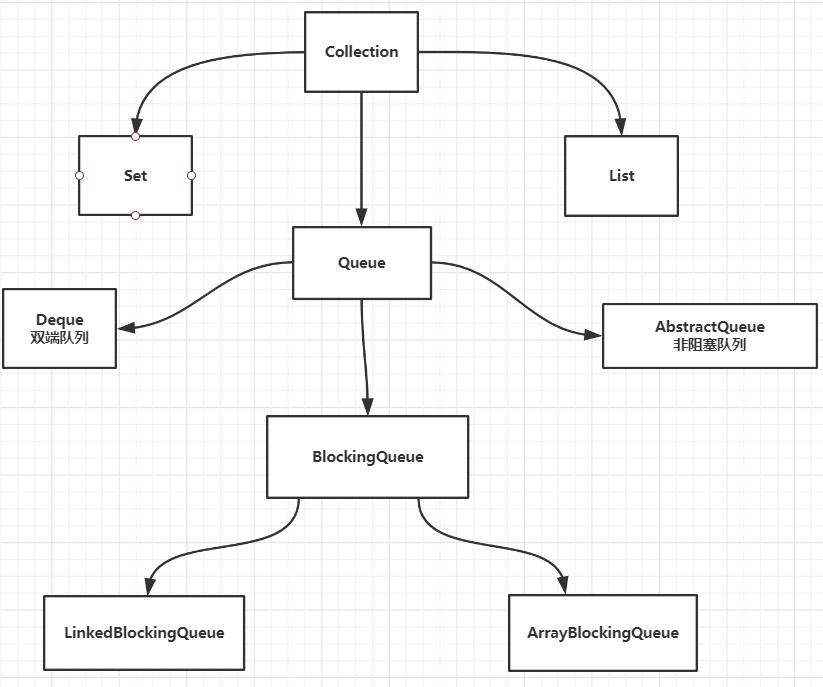
阻塞队列并不是新东西,他也是Collection的子类
阻塞队列属于队列家族,属于庞大分支的一小部分
我们什么时候使用BlockingQueue
线程池,多线程并发处理
学会使用队列
添加,移除
四组API
- 抛出异常
- 不抛出异常
- 阻塞等待
- 超时等待
| 方式 | 有返回值,抛出异常 | 有返回值,不抛出异常 | 阻塞等待 | 超时等待 |
|---|---|---|---|---|
| 添加 | add | offer | put | offer(重载) |
| 移除 | remove | poll | take | poll(重载) |
| 判断队列首 | element | peek | null | null |
- 抛出异常
import java.util.concurrent.ArrayBlockingQueue;
public class BlockQueueDemo {
public static void main(String[] args) {
test1();
test2();
}
//抛出异常
public static void test1(){
//队列的大小设为3
ArrayBlockingQueue blockingQueue = new ArrayBlockingQueue(3);
System.out.println(blockingQueue.add("A")); //true
System.out.println(blockingQueue.add("B"));//true
System.out.println(blockingQueue.add("C"));//true
//查看队首
System.out.println(blockingQueue.element()); //A
//因为队列大小为3,所以添加第四个,这里我们需要的API是抛出异常的API:java.lang.IllegalStateException: Queue full
System.out.println(blockingQueue.add("D"));
}
//抛出异常
public static void test2(){
//队列的大小设为3
ArrayBlockingQueue blockingQueue = new ArrayBlockingQueue(3);
//直接取出元素,因为什么也没有,所以不能取出,这里我们使用的是抛出异常的API:java.util.NoSuchElementException
System.out.println(blockingQueue.remove());
}
}
- 有返回值,不抛出异常
public class BlockQueueDemo {
public static void main(String[] args) {
test3();
test4();
}
//返回值
public static void test3(){
//队列的大小设为3
ArrayBlockingQueue blockingQueue = new ArrayBlockingQueue(3);
System.out.println(blockingQueue.offer("A"));//true
System.out.println(blockingQueue.offer("B"));//true
System.out.println(blockingQueue.offer("C"));//true
System.out.println(blockingQueue.peek()); //查看队首:A
//不抛出异常,有返回值
System.out.println(blockingQueue.offer("D"));//false
}
//有返回值
public static void test4(){
//队列的大小设为3
ArrayBlockingQueue blockingQueue = new ArrayBlockingQueue(3);
System.out.println(blockingQueue.poll()); //null
}
}
- 一直阻塞等待(put进去没有返回值)
public class BlockQueueDemo {
public static void main(String[] args) throws InterruptedException {
// test5();
test6();
}
//阻塞(一直等待)
public static void test5() throws InterruptedException {
//队列的大小设为3
ArrayBlockingQueue blockingQueue = new ArrayBlockingQueue(3);
blockingQueue.put("A");
blockingQueue.put("B");
blockingQueue.put("C");
//一直等待
blockingQueue.put("D");
}
//阻塞(一直等待)
public static void test6() throws InterruptedException {
//队列的大小设为3
ArrayBlockingQueue blockingQueue = new ArrayBlockingQueue(3);
System.out.println(blockingQueue.take()); //一直等待
}
}
- 超时退出
public class BlockQueueDemo {
public static void main(String[] args) throws InterruptedException {
test7();
test8();
}
//阻塞(超时等待)
public static void test7() throws InterruptedException {
//队列的大小设为3
ArrayBlockingQueue blockingQueue = new ArrayBlockingQueue(3);
blockingQueue.offer("A");
blockingQueue.offer("B");
blockingQueue.offer("C");
//超时等待
blockingQueue.offer("D", 2,TimeUnit.SECONDS);
}
//阻塞(超时等待)
public static void test8() throws InterruptedException {
//队列的大小设为3
ArrayBlockingQueue blockingQueue = new ArrayBlockingQueue(3);
System.out.println(blockingQueue.poll(2,TimeUnit.SECONDS)); //null
}
}
同步队列
SynchronouseQueue:
java.util.concurrent只能存储一个元素,进去一个元素必须等待取出来之后才能往里面存另一个元素
所以同步队列和其他的阻塞队列是不一样的
import java.util.concurrent.BlockingQueue;
import java.util.concurrent.SynchronousQueue;
import java.util.concurrent.TimeUnit;
public class SynchronousQueueDemo {
public static void main(String[] args) {
//同步队列
BlockingQueue<String> synchronousQueue = new SynchronousQueue<String>();
new Thread(()->{
try {
System.out.println(Thread.currentThread().getName()+"-->put 1");
synchronousQueue.put("1");
System.out.println(Thread.currentThread().getName()+"-->put 2");
synchronousQueue.put("2");
System.out.println(Thread.currentThread().getName()+"-->put 3");
synchronousQueue.put("3");
} catch (InterruptedException e) {
e.printStackTrace();
}
}).start();
new Thread(()->{
try {
//为了保证上面的插入完了,这里等待三秒
TimeUnit.SECONDS.sleep(3);
System.out.println(Thread.currentThread().getName()+"-->get 1");
synchronousQueue.take();
TimeUnit.SECONDS.sleep(3);
System.out.println(Thread.currentThread().getName()+"-->get 2");
synchronousQueue.take();
TimeUnit.SECONDS.sleep(3);
System.out.println(Thread.currentThread().getName()+"-->get 3");
synchronousQueue.take();
} catch (InterruptedException e) {
e.printStackTrace();
}
}).start();
}
}
/*
Thread-0-->put 1
Thread-1-->get 1
Thread-0-->put 2
Thread-1-->get 2
Thread-0-->put 3
Thread-1-->get 3
*/
线程池
线程池的东西:三大方法,七大参数,四种拒绝策略
池化技术:事先准备好一些资源,有人要用,就来我这里拿,用完之后还给我
程序的运行,本质:占用系统的资源!
优化资源的使用!=> 池化技术
线程池、连接池、内存池、对象池等等都是池
线程池的好处:
1、降低资源的消耗
2、提高响应的速度
3、方便管理
线程复用,可以控制最大并发数,管理线程

三大方法
import java.util.concurrent.Executors;
public class PoolDemo {
public static void main(String[] args) {
Executors.newSingleThreadExecutor();//线程池只有单个线程
Executors.newFixedThreadPool(5);//创建一个固定的线程池大小
Executors.newCachedThreadPool();//可伸缩的线程池,遇强则强
}
}
使用线程池的使用案例
import java.util.concurrent.ExecutorService;
import java.util.concurrent.Executors;
public class PoolDemo {
public static void main(String[] args) {
// ExecutorService threadPool = Executors.newSingleThreadExecutor();//线程池只有单个线程
// ExecutorService threadPool = Executors.newFixedThreadPool(5);//创建一个固定的线程池大小
ExecutorService threadPool = Executors.newCachedThreadPool();//可伸缩的线程池,遇强则强
//new Thread(()->{}).start();这个是以前我们创建的线程,但是从今天开始,要使用线程池来创建
//execute()里面也是一个Runnable
try {
for (int i = 0; i < 10; i++) threadPool.execute(()->System.out.println(Thread.currentThread().getName()+" ok"));
} catch (Exception e) {
e.printStackTrace();
} finally {
threadPool.shutdown();//注意,最后要关闭线程池
}
}
}
从上面的例子中分析:
第一个单个线程中,10个语句只有一条线程执行
第二个线程中,10个语句最多有第5条线程执行,也就是说最多到了5条线程同时执行
第三个线程中,10个语句最多有第10条线程执行,也就是说10条线程同时执行了,所以只要你CPU可以撑住,想多少就多少
七大参数
源码分析:
public static ExecutorService newSingleThreadExecutor() {
return new FinalizableDelegatedExecutorService
(new ThreadPoolExecutor(1, 1,
0L, TimeUnit.MILLISECONDS,
new LinkedBlockingQueue<Runnable>()));
}
public static ExecutorService newFixedThreadPool(int nThreads) {
return new ThreadPoolExecutor(nThreads, nThreads,
0L, TimeUnit.MILLISECONDS,
new LinkedBlockingQueue<Runnable>());
}
public static ExecutorService newCachedThreadPool() {
return new ThreadPoolExecutor(0, Integer.MAX_VALUE,
60L, TimeUnit.SECONDS,
new SynchronousQueue<Runnable>());
}
观察这三个线程,我们发现他们三个本质都是调用的
new ThreadPoolExecutor
七大参数:
public ThreadPoolExecutor(
int corePoolSize, //核心线程池容量
int maximumPoolSize, //线程池的最大容量
long keepAliveTime, //没有人调用则超时释放
TimeUnit unit, //超时单位
BlockingQueue<Runnable> workQueue, //阻塞队列
ThreadFactory threadFactory, //线程工厂,创建线程的,一般不用动
RejectedExecutionHandler handler //拒绝策略
) {
if (corePoolSize < 0 || maximumPoolSize <= 0 || maximumPoolSize < corePoolSize || keepAliveTime < 0) throw new IllegalArgumentException();
if (workQueue == null || threadFactory == null || handler == null) throw new NullPointerException();
this.acc = System.getSecurityManager() == null ? null : AccessController.getContext();
this.corePoolSize = corePoolSize;
this.maximumPoolSize = maximumPoolSize;
this.workQueue = workQueue;
this.keepAliveTime = unit.toNanos(keepAliveTime);
this.threadFactory = threadFactory;
this.handler = handler;
}
我们找到了这样的源码,这里有七个参数
看完了这个我们再去分析一下上面的三个线程池
public static ExecutorService newSingleThreadExecutor() {
return new FinalizableDelegatedExecutorService
(new ThreadPoolExecutor(1, 1, //核心线程为1,共有1个线程
0L, TimeUnit.MILLISECONDS,
new LinkedBlockingQueue<Runnable>()));
}
public static ExecutorService newFixedThreadPool(int nThreads) {
return new ThreadPoolExecutor(nThreads, nThreads, //核心线程和线程总数都由外界传过来,比如我们刚才的5
0L, TimeUnit.MILLISECONDS,
new LinkedBlockingQueue<Runnable>());
}
public static ExecutorService newCachedThreadPool() {
return new ThreadPoolExecutor(0, Integer.MAX_VALUE, //核心线程为0,但是最大线程可以有Integer.MAX_VALUE:21亿
60L, TimeUnit.SECONDS,
new SynchronousQueue<Runnable>());
}
如果我们使用缓存机制的线程池,电脑一定会爆出OOM
这样我们就知道了为什么阿里巴巴强制不允许使用
Executors来创建,而是通过ThreadPoolExecutor因为可能会因为内存过大导致溢出
线程池的形象解释
在生活中,我们会遇到银行排队的情况
假设现在银行中有5个窗口,候客区中有三个座位
平常人不多的时候银行窗口并不是全都开着,比如只开着两个窗口,剩下三个窗口
如上图所示,假如现在开着的窗口已经满了,又来了一个人,那么就只能到候客区中坐下等待银行办理
但是假如银行中开着的窗口满了,而候客区也满了,但是还在进人
这个时候另外三个候选窗口就要开启了
但是假如全部的窗口都满了,候客区也满了,又进来一个人
那么这个人要么走,要么等着,这就是一个策略,这就是拒绝策略
综上,银行全部的窗口就是总线程,一直开着的窗口就是核心线程,候客区就是阻塞队列,全部的位置满了之后对再进来的人的处理策略就是拒绝策略
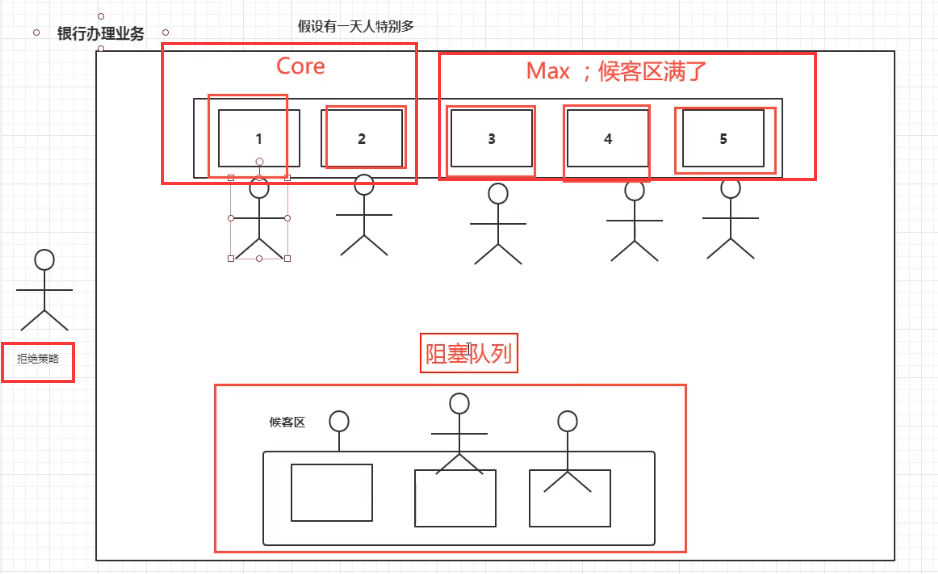
处理到了最后,所有人,或者只有剩下的两个主线程的还没有都处理完了,等待了一段时间之后,还没有更多的人来处理,那么剩下的3,4,5这三个银行端口就关闭,等待下一次开启
这个部分就叫做超时等待
四种拒绝策略
| 名称 | 拒绝策略 |
|---|---|
AbortPolicy |
抛出异常 |
CallerRunsPolicy |
回去执行,比如main线程到了新线程,那么就回到main线程执行 |
DiscardOldestPolicy |
尝试去和最早的线程竞争,竞争失败任务则不执行 |
DiscardPolicy |
不会抛出异常,但是任务不执行 |
不使用Executors创建线程池的方法
import java.util.concurrent.*;
public class PoolDemo {
public static void main(String[] args) {
ExecutorService threadPool
= new ThreadPoolExecutor(
2, //核心线程池
5, //最大线程池
3, //超时等待时间
TimeUnit.SECONDS, //时间单位
new LinkedBlockingDeque<>(3), //阻塞队列
Executors.defaultThreadFactory(), //默认的创建工厂,一般不改变
new ThreadPoolExecutor.AbortPolicy() //拒绝策略,抛出异常
);
}
}
线程<=2:只使用核心线程
2<线程<=5:使用核心线程+阻塞队列,2个线程运行,3个线程等待
5<线程<=8:使用全部线程+阻塞队列,5个线程运行,3个线程等待,最大承载
线程>8:使用全部线程+阻塞队列+抛出异常,5个线程运行,3个线程等待,其余线程执行拒绝策略
小结和扩展
调优:线程池的最大大小如何去设置
最大线程到底该如何定义
- CPU密集型
- IO密集型
CPU密集型的写法:
我们一开始的时候说到的并发和并行中,说到了cpu的核数,假如是12核的cpu,就意味着并发量为12
12条线程同时执行
那么定义为CPU密集型的时候,这个时候我们将最大线程定义为12,就可以确保电脑的利用率达到最好
我们可以使用:Runtime.getRuntime().availableProcessors()获取CPU的核数
IO密集型的写法:
一个程序有15个大型任务,IO十分占用资源,那么我们至少留15个线程执行任务,在这种情况下只要比它大就可以了
一般情况下设置为IO任务的两倍。这里是30
四大函数式接口
函数式接口
四大函数式接口(基本):java.util.function
Function,Predicate,Consumer,Supplier
其余的都是组合式接口
@FunctionalInterface:函数式接口只有一个方法的接口,比如Runnable,比如
foreach()的参数就是一个消费者类型的函数式接口public void forEach(Consumer<? super E> action) {}@FunctionalInterface public interface Consumer<T> {}函数式接口在java中超级多,在新版本的底层大量应用
- Function:函数型接口
@FunctionalInterface
public interface Function<T, R> {
R apply(T t);
default <V> Function<V, R> compose(Function<? super V, ? extends T> before) {
Objects.requireNonNull(before);
return (V v) -> apply(before.apply(v));
}
default <V> Function<T, V> andThen(Function<? super R, ? extends V> after) {
Objects.requireNonNull(after);
return (T t) -> after.apply(apply(t));
}
static <T> Function<T, T> identity() {
return t -> t;
}
}
使用:
Function<String, String> function = new Function<String, String>() {
@Override
public String apply(String s) {
return s;
}
};
//简化后:Function<String, String> function = str-> {return str;};
函数型接口:有一个输入参数,有一个输出(注意函数型接口不是函数式接口)
- Predicate:断定型接口
@FunctionalInterface
public interface Predicate<T> {
boolean test(T t);
default Predicate<T> and(Predicate<? super T> other) {
Objects.requireNonNull(other);
return (t) -> test(t) && other.test(t);
}
default Predicate<T> negate() {
return (t) -> !test(t);
}
default Predicate<T> or(Predicate<? super T> other) {
Objects.requireNonNull(other);
return (t) -> test(t) || other.test(t);
}
static <T> Predicate<T> isEqual(Object targetRef) {
return (null == targetRef)
? Objects::isNull
: object -> targetRef.equals(object);
}
}
使用:
Predicate<String> predicate = new Predicate<String>() {
@Override
public boolean test(String s) {
return s.isEmpty();
}
};
//简化后:Predicate<String> predicate =s -> {return s.isEmpty();};
断定型接口,有一个输入参数,返回值只能是布尔值
- Consumer:消费型接口
@FunctionalInterface
public interface Consumer<T> {
void accept(T t);
default Consumer<T> andThen(Consumer<? super T> after) {
Objects.requireNonNull(after);
return (T t) -> { accept(t); after.accept(t); };
}
}
使用:
Consumer<String> consumer = new Consumer<String>() {
@Override
public void accept(String s) {
System.out.println(s);
}
};
//Consumer<String> consumer = s-> System.out.println(s);
消费型接口:只有输入,没有返回值
- Supplier:供给型接口
@FunctionalInterface
public interface Supplier<T> {
T get();
}
使用:
Supplier<String> supplier = new Supplier<String>() {
@Override
public String get() {
return "str";
}
};
//Supplier<String> supplier =()->{return "str";};
供给型接口:只有输出,没有输入
Stream流计算
什么是Stream流计算
存储+计算
java.util.Stream
我们的存储使用集合,MySQL等等
计算现在交给流来做
@Data
@AllArgsConstructor
@NoArgsConstructor
public class User {
private int id;
private String name;
private int age;
}
/*
* 题目要求:一分钟之内完成此题,而且只能用一行代码实现!
* 现在有5个用户,筛选:
* 1. ID必须为偶数
* 2. 年龄必须大于23岁
* 3. 用户名字转为大写
* 4. 用户名字母倒着排序
* 5. 只输出一个用户
* */
public class Test {
public static void main(String[] args) {
User u1 = new User(1, "a", 21);
User u2 = new User(2, "b", 22);
User u3 = new User(3, "c", 23);
User u4 = new User(4, "d", 24);
User u5 = new User(5, "e", 25);
List<User> list = Arrays.asList(u1, u2, u3, u4, u5);
}
}
最后我们输出的应当是D
使用流进行计算
查看jdk:java.util.stream
stream():将集合转换为流filter():过滤,传入断定型接口,假如为true则保留,为false过滤掉map():转换,传入函数型接口,可以自由地对参数进行转换sorted():排序,默认为正序,可传入函数式接口使用compare()进行倒序排序limit():分页foreach():可以传入消费型函数式接口,一般用于遍历
/*
* 题目要求:一分钟之内完成此题,而且只能用一行代码实现!
* 现在有5个用户,筛选:
* 1. ID必须为偶数
* 2. 年龄必须大于23岁
* 3. 用户名字转为大写
* 4. 用户名字母倒着排序
* 5. 只输出一个用户
* */
public class Test {
public static void main(String[] args) {
User u1 = new User(1, "a", 21);
User u2 = new User(2, "b", 22);
User u3 = new User(3, "c", 23);
User u4 = new User(4, "d", 24);
User u5 = new User(5, "e", 25);
List<User> list = Arrays.asList(u1, u2, u3, u4, u5);
list.stream()
.filter(u->{return u.getId()%2==0;}) //选取偶数
.filter(u->{return u.getAge()>23;}) //年龄必须大于23岁
.map(u->{return u.getName().toUpperCase();}) //用户名转大写
.sorted((uu1,uu2)->{return uu2.compareTo(uu1);}) //倒序排序
.forEach(System.out::println);
}
}
ForkJoin
什么是ForkJoin
中文名字叫做分支合并
ForkJoin在JDK7的时候出现,并行执行任务,提高效率
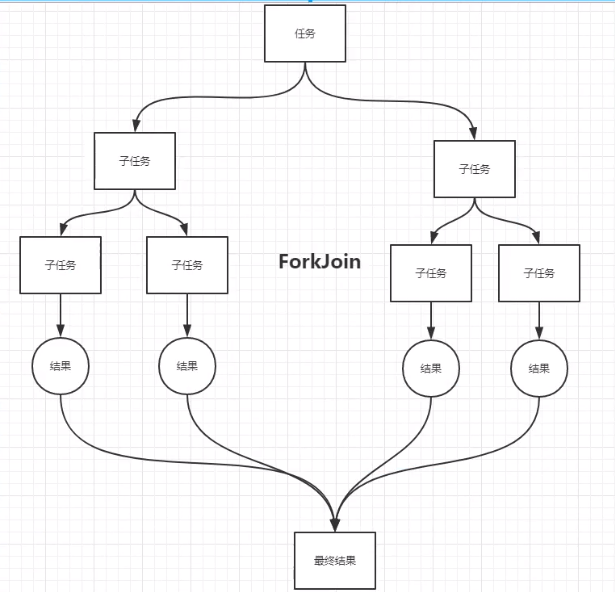
什么时候使用ForkJoin
大数据量的时候
ForkJoin特点:工作窃取
A,B维护着双端队列
假如A线程有4个任务,B线程也有4个任务
A线程还没执行完人物,但是B线程已经执行完任务了
这个时候B线程会从另一头把A线程的人物拿过来执行,不让B线程去等待
这就叫工作窃取
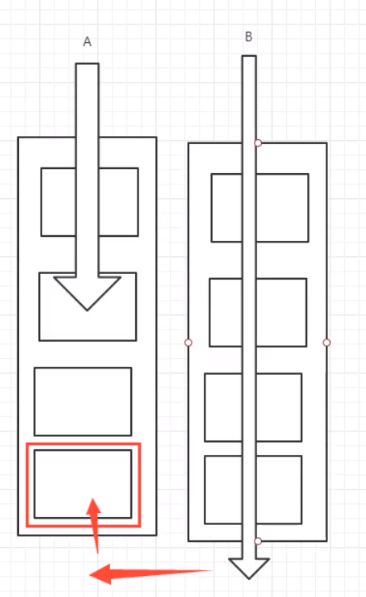
ForkJoin的操作
java.util.concurrent
ForkJoin分为两步操作:Fork,Join
-
ForkJoinPool执行
-
计算任务forkjointask执行:
forkjoinPool.execute(ForkJoinTask task)execute:同步提交
submit:异步提交
ForkJoinTask
- RecursiveAction:递归事件,没有返回值
- RecursiveTask:递归任务,有返回值
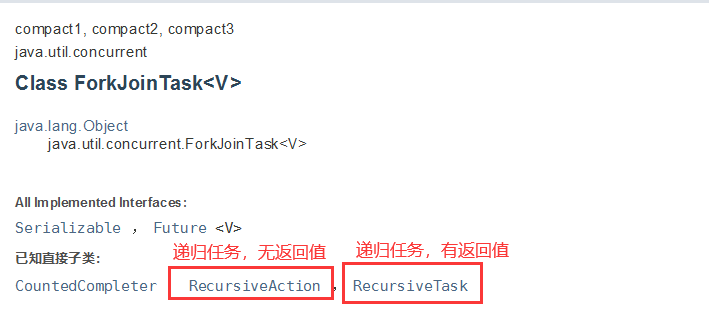
-
计算类继承
ForkJoinTask
- ForkJoinTask
import java.util.concurrent.RecursiveTask;
public class ForkJoinDemo extends RecursiveTask<Long> {
private Long start; //开始
private Long end; //结束
private Long temp = 10000L; //临界值,高于临界值使用forkjoin,小于临界值用普通方法
public ForkJoinDemo(Long start, Long end) {
this.start = start;
this.end = end;
}
//计算
@Override
protected Long compute() {
if ((end-start)<temp){
Long sum = 0L;
for (Long i = start; i <= end; i++) {
sum+=i;
}
return sum;
}else {//forkjoin
long middle = (start + end) / 2; //中间值,使用中间值将这个任务分为两个小任务
ForkJoinDemo task1 = new ForkJoinDemo(start, middle); //前半段的任务
task1.fork();//把任务压入队列
ForkJoinDemo task2 = new ForkJoinDemo(middle+1, end); //后半段的任务,注意这里是middle+1
task2.fork();//把任务压入队列
return task1.join() + task2.join(); //获得结果
}
}
}
- Test
import java.util.concurrent.ExecutionException;
import java.util.concurrent.ForkJoinPool;
import java.util.concurrent.ForkJoinTask;
import java.util.stream.LongStream;
public class Test {
public static void main(String[] args) throws ExecutionException, InterruptedException {
// test1();//sum=500000000500000000时间:8296
// test2();//sum=500000000500000000,时间:6227,这里效率还可以更高,他可以把临界值调整一下,我们这里使用的是1000L,但是如果修改之后还可以更快
test3();//sum=500000000500000000,时间:543,使用stream流还是牛逼
}
//拿3000块钱的程序员
public static void test1(){
long start = System.currentTimeMillis();
Long sum = 0L;
for (Long i = 1L; i <= 10_0000_0000L; i++) {
sum+=i;
}
long end = System.currentTimeMillis();
System.out.println("sum="+sum+",时间:"+(end-start));
}
//拿6000块钱的程序员:forkjoin
public static void test2() throws ExecutionException, InterruptedException {
long start = System.currentTimeMillis();
ForkJoinPool forkJoinPool = new ForkJoinPool();
ForkJoinTask<Long> task = new ForkJoinDemo(1L, 10_0000_0000L);
// forkJoinPool.execute(task);//执行任务,没有返回值
ForkJoinTask<Long> submit = forkJoinPool.submit(task);//提交任务,有返回值
Long sum = submit.get();//需要阻塞等待
long end = System.currentTimeMillis();
System.out.println("sum="+sum+",时间:"+(end-start));
}
//拿9000块钱的程序员:stream
public static void test3() throws ExecutionException, InterruptedException {
long start = System.currentTimeMillis();
//range()和rangeClose()的选择区间:range左右不包含,rangeClose左开右闭
long sum = LongStream.rangeClosed(0L, 10_0000_0000L).parallel().reduce(0, Long::sum);
long end = System.currentTimeMillis();
System.out.println("sum="+sum+",时间:"+(end-start));
}
}
从上面那个案例中可以看出,真要计算还是要是用stream流,但是forkjoin也是要会用
而且我们也知道了流还有LongStream,那么其他的DoubleStream,IntStream等等,没有区别
异步回调
Future:设计的初衷就是对未来的某个事件进行建模
java.util.concurrent
异步回调说白了就三个:
- 异步执行
- 成功回调
- 失败回调
Future的实现类:CompletableFuture
import java.util.concurrent.CompletableFuture;
import java.util.concurrent.ExecutionException;
import java.util.concurrent.TimeUnit;
//异步调用
public class Demo01 {
public static void main(String[] args) throws ExecutionException, InterruptedException {
// resultNull();
resultNotNull();
}
public static void resultNull() throws ExecutionException, InterruptedException {
//发起一个请求
//没有返回值的异步回调,注意这里的Void
CompletableFuture<Void> completedFuture = CompletableFuture.runAsync(()->{
try {
TimeUnit.SECONDS.sleep(2);//这里模拟结果执行
} catch (InterruptedException e) {
e.printStackTrace();
}
System.out.println(Thread.currentThread().getName());
});
completedFuture.get();//他要等待completedFuture的结果执行完毕才会得到结果,所以获取执行结果会阻塞
/*
上面的这个例子可以理解一下,我们可以把任务放到completedFuture里面去执行
然后等到我们需要结果的时候只需要执行completedFuture.get();就可以获得相应的结果
*/
}
public static void resultNotNull() throws ExecutionException, InterruptedException {
//有返回值的异步回调
CompletableFuture<Integer> completableFuture = CompletableFuture.supplyAsync(()->{
return 1024;
});
Integer result = completableFuture
.whenComplete((t, u) -> { //编译成功
System.out.println("t=>" + t);//正常的返回结果,这里是1024
System.out.println("u=>" + u);//错误信息
})
.exceptionally((e) -> { //编译失败
System.out.println(e.getMessage());
e.printStackTrace();
return 233;
}).get();//.get()得到结果
System.out.println(result);
}
}
JMM
请你谈谈 Volatile的理解
Volatile是JAVA虚拟机提供轻量级的同步机制
1、保证可见性
2、不保证原子性
3、禁止指令重排
可见性--》JMM
什么是JMM
JMM:Java内存模型,这个是不存在的东西,是一种概念,约定
关于JMM的同步约定
1、线程解锁前,必须把共享变量立刻刷新到主存
我们知道线程的操作是:将主内存的共享变量复制一份到线程自己的工作内存中
那么线程在解锁之前必须立刻把自己工作内存中的值刷新到主存中
2、线程加锁前:必须读取主存中的最新值到工作内存中
3、加锁和解锁必须是同一把锁
线程中分为工作内存和主内存
线程工作时会将内存中的数据刷到工作内存中,工作完成之后会将数据再次刷回主内存中
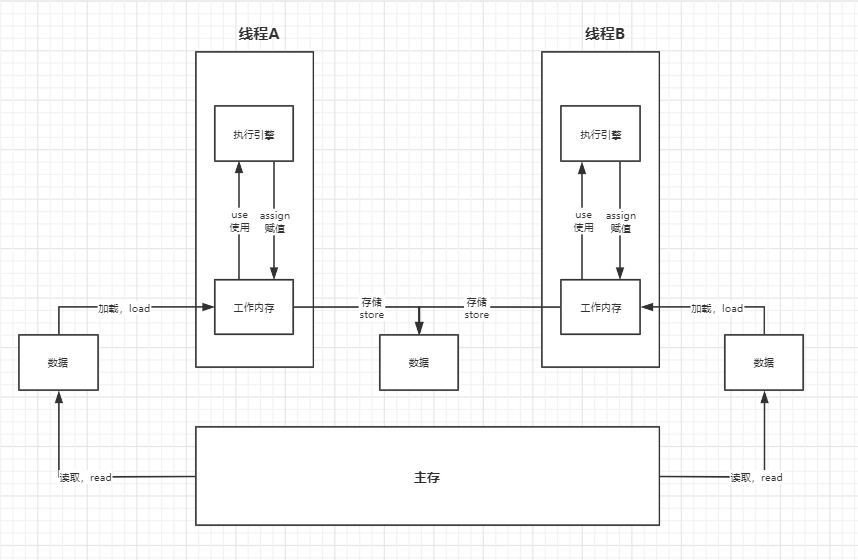
内存交互操作有8种,虚拟机实现必须保证每一个操作都是原子的,不可在分的
对于double和long类型的变量来说,load、store、read和write操作在某些平台上允许例外
- lock (锁定):作用于主内存的变量,把一个变量标识为线程独占状态
- unlock (解锁):作用于主内存的变量,它把一个处于锁定状态的变量释放出来,释放后的变量才可以被其他线程锁定
- read (读取):作用于主内存变量,它把一个变量的值从主内存传输到线程的工作内存中,以便随后的load动作使用
- load (载入):作用于工作内存的变量,它把read操作从主存中变量放入工作内存中
- use (使用):作用于工作内存中的变量,它把工作内存中的变量传输给执行引擎,每当虚拟机遇到一个需要使用到变量的值,就会使用到这个指令
- assign (赋值):作用于工作内存中的变量,它把一个从执行引擎中接受到的值放入工作内存的变量副本中
- store (存储):作用于主内存中的变量,它把一个从工作内存中一个变量的值传送到主内存中,以便后续的write使用
- write (写入):作用于主内存中的变量,它把store操作从工作内存中得到的变量的值放入主内存的变量中
JMM对这八种指令的使用,制定了如下规则:
- 不允许read和load、store和write操作之一单独出现。即
使用了read必须load,使用了store必须write - 不允许线程丢弃他最近的assign操作,即工作变量的数据改变了之后,必须告知主存
- 不允许一个线程将没有assign的数据从工作内存同步回主内存
- 一个新的变量必须在主内存中诞生,不允许工作内存直接使用一个未被初始化的变量。就是对s变量实施use、store操作之前,必须经过assign和load操作
- 一个变量同一时间只有一个线程能对其进行lock。多次lock后,必须执行相同次数的unlock才能解锁
- 如果对一个变量进行lock操作,会清空所有工作内存中此变量的值,在执行引擎使用这个变量前,必须重新load或assign操作初始化变量的值
- 如果一个变量没有被lock,就不能对其进行unlock操作。也不能unlock一个被其他线程锁住的变量
- 对一个变量进行unlock操作之前,必须把此变量同步回主内存
Volatile
问题
那么现在有一个问题:
线程B修改了值,但是线程A不能及时可见

import java.util.concurrent.TimeUnit;
public class JMMDemo {
private static boolean flag = true;
public static void main(String[] args) {
new Thread(()->{
while (flag){
}
}).start();
try {
TimeUnit.SECONDS.sleep(2);
} catch (InterruptedException e) {
e.printStackTrace();
}
flag = false;
System.out.println(flag);
}
}
如果按照正常的逻辑,这里是应该是当flag = true的时候一直进入while,但是将flag = false
修改之后结束循环
但是事实却是当flag输出为False的时候程序还没有结束
Volatile的三大特点
保证可见性
对上面的代码进行改造,假如volatile关键字
import java.util.concurrent.TimeUnit;
public class volatileDemo {
private volatile static boolean flag = true;
public static void main(String[] args) {
new Thread(()->{
while (flag){
}
}).start();
try {
TimeUnit.SECONDS.sleep(2);
} catch (InterruptedException e) {
e.printStackTrace();
}
flag = false;
System.out.println(flag);
}
}
当控制台打印出:flag的时候,程序就已经停止
Volatile不需要进行阻塞即可将结果展示给所有的线程,所以不用线程阻塞
不保证原子性
原子性:操作不可分割,要么一起完成,要么不完成
//不保证原子性
public class volatileDemo2 {
private volatile static int num = 0;
public static void add(){
num++;
}
public static void main(String[] args) {
for (int i = 1; i <= 100; i++) {
new Thread(()->{
for (int i1 = 0; i1 < 100; i1++) {
add();
}
}).start();
}
while (Thread.activeCount()>2){//假如除了main线程和gc线程之外还有其他的线程
Thread.yield();//那么就让main线程去礼让其他的线程,让他们跑完
}
System.out.println(num);
}
}
//这次是9907
我们可以看到了,volatil3不能保证原子操作
我们通过:javap -c volatileDemo2.class来将class文件反编译,查询到:

- 获得这个值
- 执行+1
- 写会这个值
那么不加lock或者synchronized,如何保证原子性操作?
volatile不可以保证原子操作,那么可以使用lock锁或者synchronized保证原子操作,但是我们要说一个更厉害的:
在java.util.concurrent.atomic 中,都是原子操作,其中有一个AtomicInteger
那么我们对这个程序进行更改
import java.util.concurrent.atomic.AtomicInteger;
//不保证原子性
public class volatileDemo2 {
// private volatile static int num = 0;
private volatile static AtomicInteger num = new AtomicInteger();
public static void add(){
num.getAndIncrement();//执行+1操作
}
public static void main(String[] args) {
for (int i = 1; i <= 100; i++) {
new Thread(()->{
for (int i1 = 0; i1 < 100; i1++) {
add();
}
}).start();
}
while (Thread.activeCount()>2){//假如除了main线程和gc线程之外还有其他的线程
Thread.yield();//那么就让main线程去礼让其他的线程,让他们跑完
}
System.out.println(num);
}
}
不论怎么测试,这个就变成了10000,不再变化,说明这才是保证的原子操作
那么为什么atomic这么厉害可以保证原子操作?
因为这些类的底层都和操作系统挂钩,在内存中修改值
禁止指令重排
指令重排:计算机并不是按照你写的程序进行执行的
从源代码到执行之间的可能性:编译器优化的重排,指令并行可能会重排,内存系统可能会重排
案例一:
比如:我写了一个
int x = 1; //第1步
int y = 2; //第2步
x = x + 5; //第3步
y = x * x; //第4步
我们期望的是 1234,但是在计算机中可能会被重新排列为2134,1324
但是不会为4123
因为不管是2134还是1324都不会对数据产生影响,但是4123会对数据产生影响
处理器在考虑指令重排的时候会考虑数据之间的相互依赖
案例二:
但是在多线程下看一个可能造成影响的结果:有 a b x y,这四个默认值都是0
| 线程A | 线程B |
|---|---|
| x = a | y = b |
| b = 1 | a = 2 |
正常的结果是:x = 0,y =0
但是指令重排之后可能会造成线程A中和线程B中的顺序进行颠倒
| 线程A | 线程B |
|---|---|
| b = 1 | a = 2 |
| x = a | y = b |
重排之后的诡异结果:x = 2,y = 1
平时的时候是不会出现这种问题的,但是在理论上这个问题是存在的,所以即使这个问题没有出现我们也要预防可能发生的结果
volatile可以避免指令重排的依仗:
在计算机中存在着一个叫做内存屏障的东西
内存屏障的作用:可以保证特定的执行顺序
可以保证某些变量的内存可见性(volatile就是利用这些特性实现了可见性)
volatile就是在他之前和之后都加上了内存屏障

单例模式
饿汉式单例
//饿汉式单例
public class Hungry {
private byte[] data1 = new byte[1024*1024];
private byte[] data2 = new byte[1024*1024];
private byte[] data3 = new byte[1024*1024];
private byte[] data4 = new byte[1024*1024];
private Hungry() {
}
//一开始就创建了,可能会浪费空间
private static final Hungry HUNGRY = new Hungry();
public static Hungry getInstance(){
return HUNGRY;
}
}
单例模式首先要进行构造器私有
懒汉式单例
//DCL懒汉式单例
public class Lazy {
public Lazy() {
}
private static Lazy lazy;
public static Lazy getInstance(){
if (lazy!=null){
lazy = new Lazy();
}
return lazy;
}
}
饿汉式单例虽然浪费资源,但是在多线程的情况下貌似是没有问题的,但是懒汉式单例在多线程下可能就出现了问题
//DCL懒汉式单例
public class LazyMan {
private LazyMan() {
System.out.println(Thread.currentThread().getName()+" ok");
}
private static LazyMan lazyMan;
public static LazyMan getInstance(){
if (lazyMan ==null){
lazyMan = new LazyMan();
}
return lazyMan;
}
public static void main(String[] args) {
for (int i = 0; i < 10; i++) {
new Thread(()->{
LazyMan.getInstance();
}).start();
}
}
}
//Thread-2 ok
//Thread-1 ok
//Thread-0 ok
很明显,多线程下单例是有问题的,构造方法执行了三次,他们拿到的并不是一个,单例模式失败了
我们可以使用锁来解决多线程的一个夺取问题
public static LazyMan getInstance(){
if (lazyMan ==null){
synchronized (LazyMan.class){
if (lazyMan==null){
lazyMan = new LazyMan();
}
}
}
return lazyMan;
}
使用双重检测锁模式来检测DCL懒汉式单例,我们再次运行,发现没有问题了,从始至终都只有一个
Thread-0 ok,说明构造方法只执行了一次,单例模式执行Ok
但是这样其实并不保险,因为lazyMan = new LazyMan()它不是一个原子性操作,至少要执行三步:
- 分配内存空间
- 执行构造方法初始化对象
- 把对象指向空间
这个时候也有可能出现指令重排的现象,比如改为132。
对于多线程模式下者就完蛋了,因为可能A线程执行了13,然后B线程来了,发现lazyMan!=null,这个时候直接return lazyMan,但是事实上还没有完成构造,这就完蛋了
所以为了防止指令重排,必须加上volatile
private LazyMan() {
System.out.println(Thread.currentThread().getName()+" ok");
}
private static volatile LazyMan lazyMan;
public static LazyMan getInstance(){
if (lazyMan ==null){
synchronized (LazyMan.class){
if (lazyMan==null){
lazyMan = new LazyMan();
}
}
}
return lazyMan;
}
这才是最终的双重检测锁模式
静态内部类
静态内部类实现
//静态内部类实现
public class Holder {
private Holder(){}
public static Holder getInstance(){
return InnerClass.HOLDER;
}
public static class InnerClass{
private static final Holder HOLDER = new Holder();
}
}
静态内部类看起来虽然不错,但是其实并没有什么卵用
利用反射破解单例模式
单例模式其实都是不安全的,比如我们现在要破解DCL懒汉式单例
import java.lang.reflect.Constructor;
//懒汉式单例
public class LazyMan {
private LazyMan() {}
private volatile static LazyMan lazyMan;
public static LazyMan getInstance(){
if (lazyMan ==null){
synchronized (LazyMan.class){
if (lazyMan==null){
lazyMan = new LazyMan();
}
}
}
return lazyMan;
}
public static void main(String[] args) throws Exception {
LazyMan lazyMan1 = LazyMan.getInstance();//普通方法获得
//利用反射破坏单例获得
Constructor<LazyMan> declaredConstructor = LazyMan.class.getDeclaredConstructor(null);
declaredConstructor.setAccessible(true);
LazyMan lazyMan2 = declaredConstructor.newInstance();
System.out.println(lazyMan1);//com.bean.single.LazyMan@74a14482
System.out.println(lazyMan2);//com.bean.single.LazyMan@1540e19d
}
}
现在看的很清楚了,他们两个不一样,单例被破坏了
解决单例的破坏问题:加锁
//懒汉式单例
public class LazyMan {
private LazyMan() {
synchronized (LazyMan.class){
if (lazyMan!=null){
throw new RuntimeException("不要使用反射破坏");
}
}
}
private volatile static LazyMan lazyMan;
public static LazyMan getInstance(){
if (lazyMan ==null){
synchronized (LazyMan.class){
if (lazyMan==null){
lazyMan = new LazyMan();
}
}
}
return lazyMan;
}
public static void main(String[] args) throws Exception {
LazyMan lazyMan1 = LazyMan.getInstance();//普通方法获得
//利用反射破坏单例获得
Constructor<LazyMan> declaredConstructor = LazyMan.class.getDeclaredConstructor(null);
declaredConstructor.setAccessible(true);
LazyMan lazyMan2 = declaredConstructor.newInstance();
System.out.println(lazyMan1);
System.out.println(lazyMan2);
}
}
我们直接在类模板上加了一个锁,普通情况下已经有了
lazyMan的时候不会执行构造方法,但是现在还是执行了说明有人在用反射破坏
执行之后发现抛出了异常,没有问题
java.lang.RuntimeException: 不要使用反射破坏现在成为了三重检测
虽然这样检测,其实还是可以破坏的
LazyMan lazyMan1 = LazyMan.getInstance();
我们之前看到的第一个对象是用这种普通方法去创建的,所以会执行构造方法
但是现在我不用这个方法,我直接不创建这个对象,直接使用方法,那单例模式就又被破坏了
public static void main(String[] args) throws Exception {
// LazyMan lazyMan1 = LazyMan.getInstance();//普通方法获得
//利用反射破坏单例获得
Constructor<LazyMan> declaredConstructor = LazyMan.class.getDeclaredConstructor(null);
declaredConstructor.setAccessible(true);
LazyMan lazyMan1 = declaredConstructor.newInstance();//现在直接不创建对象,直接使用这个方法,那单例完蛋了
LazyMan lazyMan2 = declaredConstructor.newInstance();
System.out.println(lazyMan1);//com.bean.single.LazyMan@74a14482
System.out.println(lazyMan2);//com.bean.single.LazyMan@1540e19d
}
即便是这样,还是有办法来解决的:
使用红绿灯办法,设置一个flag变量,在不知道这个变量的情况下,反射还是不能破坏
//懒汉式单例
public class LazyMan {
private static boolean flag = false;
private LazyMan() {
synchronized (LazyMan.class){
if (flag==false){
flag = true;
}else {
throw new RuntimeException("不要使用反射破坏");
}
}
}
private volatile static LazyMan lazyMan;
public static LazyMan getInstance(){
if (lazyMan ==null){
synchronized (LazyMan.class){
if (lazyMan==null){
lazyMan = new LazyMan();
}
}
}
return lazyMan;
}
public static void main(String[] args) throws Exception {
// LazyMan lazyMan1 = LazyMan.getInstance();//普通方法获得
//利用反射破坏单例获得
Constructor<LazyMan> declaredConstructor = LazyMan.class.getDeclaredConstructor(null);
declaredConstructor.setAccessible(true);
LazyMan lazyMan1 = declaredConstructor.newInstance();
LazyMan lazyMan2 = declaredConstructor.newInstance();
//java.lang.RuntimeException: 不要使用反射破坏
System.out.println(lazyMan1);
System.out.println(lazyMan2);
}
}
不管是不是要创建对象,构造方法总是要走的,只要一走构造方法,flag就会变为true,然后就可以防止反射被破坏
但是这样依旧不安全,我们可以使用反编译的方式查看这个变量。
public static void main(String[] args) throws Exception {
Constructor<LazyMan> declaredConstructor = LazyMan.class.getDeclaredConstructor(null);
declaredConstructor.setAccessible(true);
LazyMan lazyMan1 = declaredConstructor.newInstance();
Field flag = LazyMan.class.getDeclaredField("flag");
flag.setAccessible(true);
flag.set(lazyMan1,false);
LazyMan lazyMan2 = declaredConstructor.newInstance();
System.out.println(lazyMan1);
System.out.println(lazyMan2);
}
单例又被破坏了
这样还是可以防止的:我们可以使用枚举防止单例被破坏,反射是不能破坏枚举的
public enum EnumSingle {
INSTANCE;
public EnumSingle getInstance(){
return INSTANCE;
}
}
我们通过查看它的class文件可以发现它是一个无参构造
public enum EnumSingle { INSTANCE; private EnumSingle() { } public EnumSingle getInstance() { return INSTANCE; } }
class Test{
public static void main(String[] args) throws Exception {
EnumSingle instance = EnumSingle.INSTANCE;
Constructor<EnumSingle> declaredConstructor = EnumSingle.class.getDeclaredConstructor(null);
declaredConstructor.setAccessible(true);
EnumSingle enumSingle = declaredConstructor.newInstance();
}
}
java.lang.NoSuchMethodException: com.bean.single.EnumSingle.<init>()报错了,他说没有这个构造方法
问题来了,明明有这个构造方法,却说没有,这个说明class文件欺骗了我们,通过反编译
javap -c xxx.class来查看
发现还是空参方法,说明这个也骗了我们
那么使用专业的工具
jad.exe,反编译成java文件,查看出来:
构造方法变了,不是空参的构造方法
那就好办了,继续破解
class Test{
public static void main(String[] args) throws Exception {
EnumSingle instance = EnumSingle.INSTANCE;
Constructor<EnumSingle> declaredConstructor = EnumSingle.class.getDeclaredConstructor(String.class,int.class);
declaredConstructor.setAccessible(true);
EnumSingle enumSingle = declaredConstructor.newInstance();
}
}
执行,发现错误变了:
Cannot reflectively create enum objects反射不能破坏枚举对象
到此为止,交锋结束了
枚举确实好使
CAS
什么是CAS
CAS:比较当前内存中的值和主内存中的值,如果这个值是期望的,那么则执行操作,如果不是则一直循环
import java.util.concurrent.atomic.AtomicInteger;
//CAS:compare and set-->比较并交换
//CAS是CPU的并发原语
public class CASDemo {
public static void main(String[] args) {
//之前的AtomicInteger其实就是使用了CAS
AtomicInteger atomicInteger = new AtomicInteger(2020);
//期望,更新
//public final boolean compareAndSet(int expect,int update)
//如果我期望的值达到了,那么就更新,否则就不更新
System.out.println(atomicInteger.compareAndSet(2020, 2021));
System.out.println(atomicInteger.get());//2021
//再次修改就会修改失败,因为只有2020才能够修改为2021,但是上面已经修改为了2021
System.out.println(atomicInteger.compareAndSet(2020, 2021));
}
}
Unsafe类
之前我们使用过AtomicInteger的+1操作,现在来看一下底层
public final int getAndIncrement() {
return unsafe.getAndAddInt(this, valueOffset, 1);
}
private static final Unsafe unsafe = Unsafe.getUnsafe();
private static final long valueOffset;
static {
try {
valueOffset = unsafe.objectFieldOffset //获得内存地址偏移值
(AtomicInteger.class.getDeclaredField("value"));
} catch (Exception ex) { throw new Error(ex); }
}
private volatile int value; //避免指令重排
unsafe类:
- Java不可以操作内存
- Java可以调用c++
- c++可以操作内存
所以这个类是Java的后门,可以通过这个类来操作内存

getAndAddInt:当前对象,当前地址偏移值,要增加的值
所以
var5就是获取当前对象的地址偏移值,也就是获取内存地址中的值
compareAndSwapInt(var1, var2, var5, var5 + var4)如果当前的地址偏移值还是我期望的那个地址偏移值,那么就让他+v4
如果var1+var2还是期望的那个地址偏移值var5,那么就让var5+var4
所以这是一个内存操作,效率非常高
atomicInteger.getAndIncrement()所以这是一个标准的自旋锁
CAS的优缺点
优点:自带原子性
缺点:
- 循环会耗时,但是比java强多了
- 一次性只能保证一个共享变量的原子性
- ABA问题
CAS:ABA问题(狸猫换太子)
现在有一个资源A = 1,两条线程
线程1期望A=1,要通过CAS修改为2
线程2也期望A=1,要通过CAS修改为3
线程3期望A=3,要通过CAS修改为1
那么现在:线程2因为操作比较快,将A修改为了3,然后又被线程3修改回了1
这个过程,线程1是不知情的,它拿到了资源A,那么这个时候A = 1
这个线程1以为A还是之前那个A,但是其实已经被动过手脚了
这就是ABA问题
测试
import java.util.concurrent.atomic.AtomicInteger;
//CAS:compare and set-->比较并交换
//CAS是CPU的并发原语
public class CASDemo {
public static void main(String[] args) {
AtomicInteger atomicInteger = new AtomicInteger(2020);
/*==================捣乱的线程==================*/
System.out.println(atomicInteger.compareAndSet(2020, 2021));
System.out.println(atomicInteger.get());
System.out.println(atomicInteger.compareAndSet(2021, 2020));
System.out.println(atomicInteger.get());
/*==================期望的线程==================*/
System.out.println(atomicInteger.compareAndSet(2020, 6666));
System.out.println(atomicInteger.get());
}
}
对于我们写的SQL,只要写上一把乐观锁,就可以解决这个问题
原子引用解决ABA
带版本号的原子操作
java.util.concurrent.atomic.AtomicReference:原子引用
//CAS:compare and set-->比较并交换
//CAS是CPU的并发原语
public class CASDemo {
public static void main(String[] args) {
// AtomicInteger atomicInteger = new AtomicInteger(2020);
//替换AtomicInteger,使用带有版本号的AtomicStampedReference,有两个参数:期望值,版本号
/*
注意,这里的Integer,Integer使用了对象缓存机制,默认范围是-128~127,推荐使用静态工厂方法valueOf获取对象实例,而不是new
因为valueOf使用缓存,new一定会创建新的对象分配新的内存空间
因为一开始的默认值是2020,超出了Integer的范围,所以出现了错误
而且所有相同类型的包装类之间的比较要全部使用equals,这是因为在-128~127之间是从缓存中产生的,在这个区间中会复用已有对象,可以使用==
但是超过了这个区间就会在堆上产生,并不会复用已有的对象,那么指向的并不是一个,所以会出现问题
这是一个大坑
所以泛型如果是一个包装类,就要注意对象的引用问题
*/
AtomicStampedReference<Integer> atomicStampedReference = new AtomicStampedReference<>(1,1);
new Thread(()->{
System.out.println("A1 ==>"+atomicStampedReference.getStamp());//获取版本号
try {
TimeUnit.SECONDS.sleep(1);
} catch (InterruptedException e) {
e.printStackTrace();
}
//期望的值为1,修改的值为2。修改值并执行版本号+1
System.out.println(atomicStampedReference.compareAndSet(1, 2, atomicStampedReference.getStamp(), atomicStampedReference.getStamp() + 1));
System.out.println("A2 ==>"+atomicStampedReference.getStamp());//获取版本号
//再把值改回去
System.out.println(atomicStampedReference.compareAndSet(2, 1, atomicStampedReference.getStamp(), atomicStampedReference.getStamp() + 1));
System.out.println("A3 ==>"+atomicStampedReference.getStamp());//获取版本号
},"A").start();
new Thread(()->{
System.out.println("B1 ==>"+atomicStampedReference.getStamp());//获取版本号
try {
TimeUnit.SECONDS.sleep(2);
} catch (InterruptedException e) {
e.printStackTrace();
}
System.out.println(atomicStampedReference.compareAndSet(1, 6, atomicStampedReference.getStamp(), atomicStampedReference.getStamp() + 1));
System.out.println("B2 ==>"+atomicStampedReference.getStamp());
},"B").start();
}
}
锁
公平锁,非公平锁
公平锁:非常公平,一个队列不能插队
非公平锁:可以插队
默认都是非公平

在前面的Lock锁就已经讲过了
可重入锁
所有的锁都是可重入锁,也叫递归锁
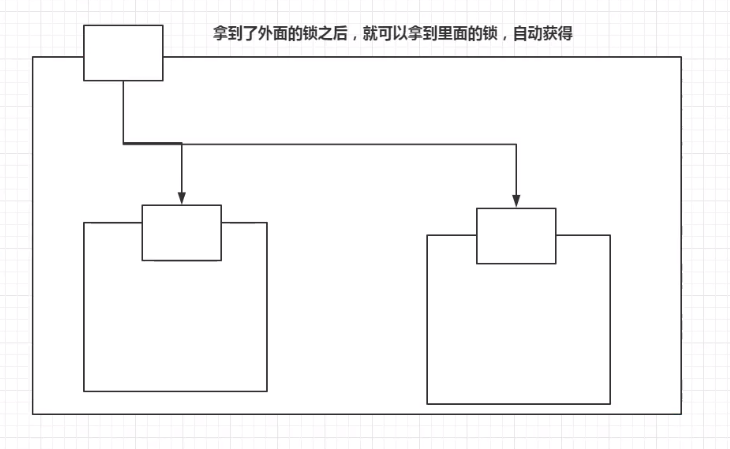
//可重入锁
public class Demo01 {
public static void main(String[] args) {
Phone phone = new Phone();
new Thread(()->{
phone.sms();
},"A").start();
new Thread(()->{
phone.sms();
},"B").start();
}
}
class Phone{
public synchronized void sms(){
System.out.println(Thread.currentThread().getName()+"sms");
call();//这里也有锁
}
public synchronized void call(){
System.out.println(Thread.currentThread().getName()+"call");
}
}
/*
Asms
Acall
Bsms
Bcall
*/
在上面我们可以知道,无论执行多少次,A都会先执行完,然后释放锁
这里A获得的是两个锁:sms方法和call方法的锁
这就是可重入锁,A获取了sms的锁之后自动获得call的锁
使用Lock锁也是一样的结果,本质上是一样的
import java.util.concurrent.locks.Lock;
import java.util.concurrent.locks.ReentrantLock;
//可重入锁
public class Demo02 {
public static void main(String[] args) {
Phone phone = new Phone();
new Thread(()->{
phone.sms();
},"A").start();
new Thread(()->{
phone.sms();
},"B").start();
}
}
class Phone2{
Lock lock = new ReentrantLock();
public void sms(){
lock.lock();//加锁
try {
System.out.println(Thread.currentThread().getName()+"sms");
call();//这里也有锁
} catch (Exception e) {
e.printStackTrace();
} finally {
lock.unlock();//解锁
}
}
public synchronized void call(){
lock.lock(); //加锁,注意这里的锁和上面的锁不是同一把锁
try {
System.out.println(Thread.currentThread().getName()+"call");
} catch (Exception e) {
e.printStackTrace();
} finally {
lock.unlock();//解锁,注意这里的锁和上面的锁不是同一把锁
}
}
}
自旋锁
spinlock,自旋锁,这种锁会不断循环,直到成功

//自旋锁
public class SpinlockDemo {
AtomicReference<Thread> atomicReference = new AtomicReference<>();
//加锁
public void myLock(){
Thread thread = Thread.currentThread();//获取当前的线程
System.out.println(Thread.currentThread().getName()+" ==> mylock");
//自旋锁,使用CAS,我们的期望值为null,然后设为thread
//这个CAS操作返回肯定是false,所以我们对他进行取反,让它一直循环
while (!atomicReference.compareAndSet(null,thread)){
}
}
//解锁
public void myUnLock(){
Thread thread = Thread.currentThread();//获取当前的线程
System.out.println(Thread.currentThread().getName()+"==>myUnLock");
//加锁自旋,解锁就不需要了
//我们期望值为thread当前线程,把它置为空
//以达到lock锁while循环解锁的条件
atomicReference.compareAndSet(thread,null);
}
}
import java.util.concurrent.TimeUnit;
public class TestSpinLock {
public static void main(String[] args) {
//第层使用了自旋锁,使用CAS操作
SpinlockDemo lock = new SpinlockDemo();
new Thread(()->{
lock.myLock();
try {
TimeUnit.SECONDS.sleep(5);//休息一下
} catch (InterruptedException e) {
e.printStackTrace();
} finally {
lock.myUnLock();
}
},"T1").start();
//我们休息一秒钟,保证t1可以先获取到锁
try {
TimeUnit.SECONDS.sleep(1);
} catch (InterruptedException e) {
e.printStackTrace();
}
new Thread(()->{
lock.myLock();
try {
TimeUnit.SECONDS.sleep(1);//t2也休息一下
} catch (InterruptedException e) {
e.printStackTrace();
} finally {
lock.myUnLock();
}
},"T2").start();
}
}
/*
T1 ==> mylock
T2 ==> mylock
T1==>myUnLock
T2==>myUnLock
*/
这样答案很明显了
只有当T1释放了锁之后,T2才有资格释放锁
情况是这样的:
t1首先执行了mylock的输出,然后使用了CAS
然后t2执行了mylock的输出,但是因为CAS正在修改t1,所以t2一直在等待
然后t1执行了unlock
t2使用了CAS,然后执行了unlock
如果不信,可以吧lock输出放到while之后,然后再执行一遍看看
死锁
什么是死锁
死锁就是两个线程互相抢对方的锁
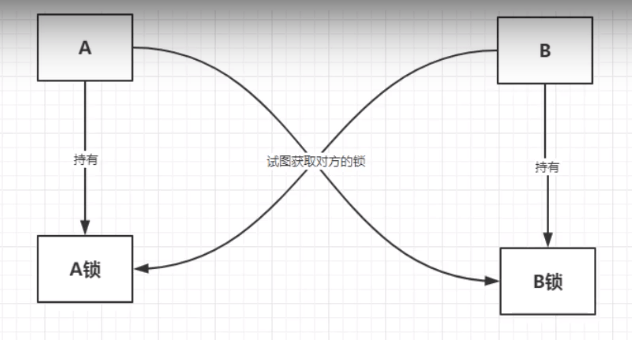
怎么排除死锁
解决问题
-
使用
jps -l定位进程号
-
使用
jstack 进程号找到死锁问题
面试或者工作中,出现问题可以查看:日志,堆栈信息



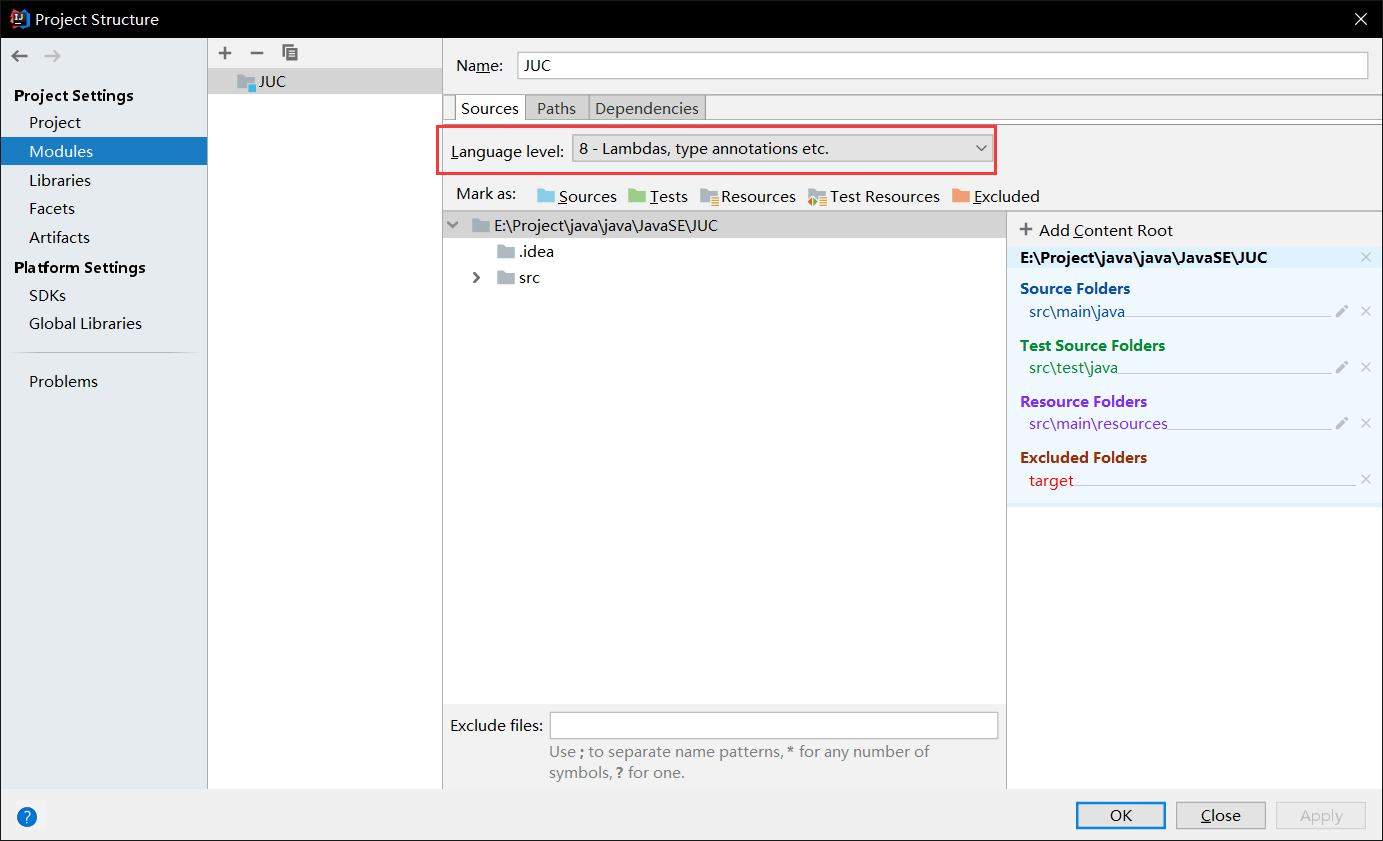

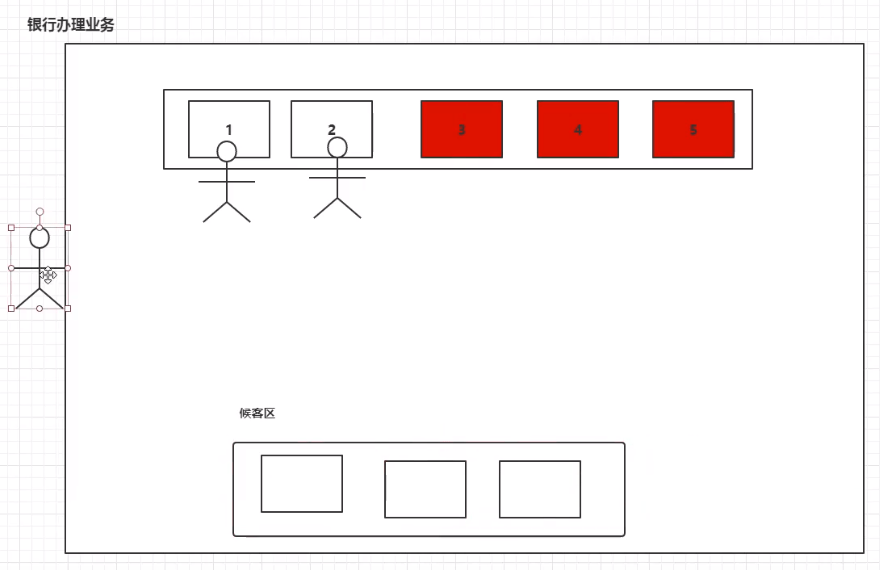
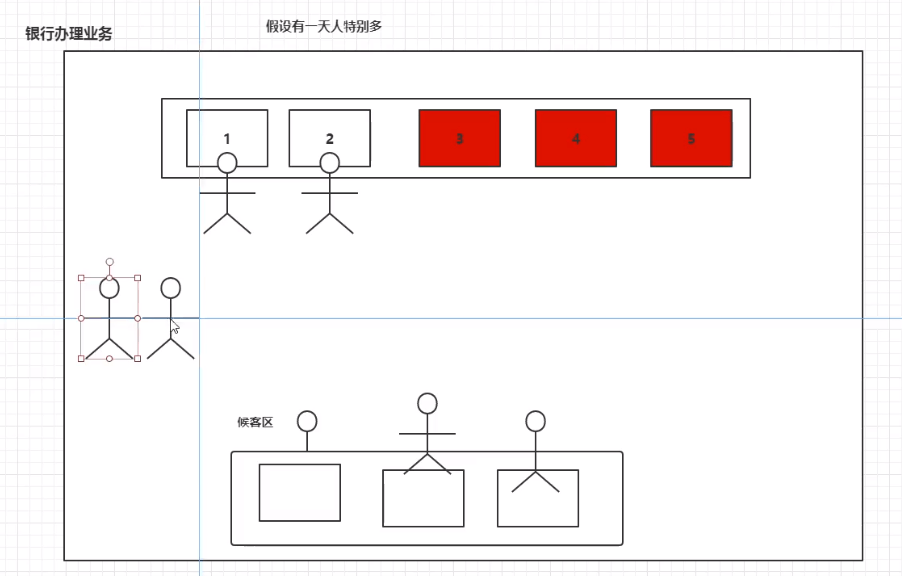



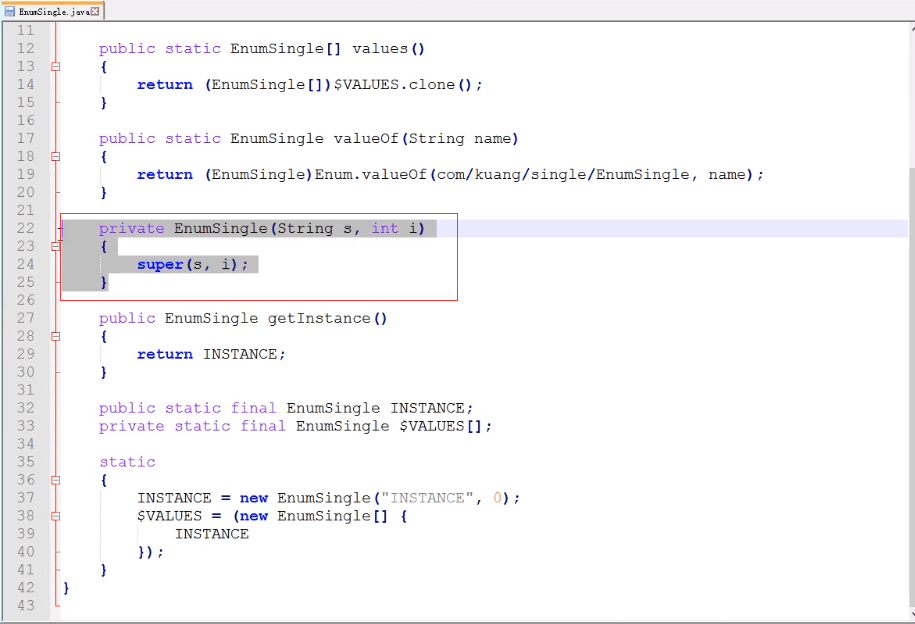

 浙公网安备 33010602011771号
浙公网安备 33010602011771号